This is the world's best lemon drizzle cake! It's truly the zingiest, most delicious and moreish cake you’ll ever make. The recipe is easy to follow and the crumb is incredibly soft and tender. It genuinely rivals Mary Berry's lemon drizzle cake.
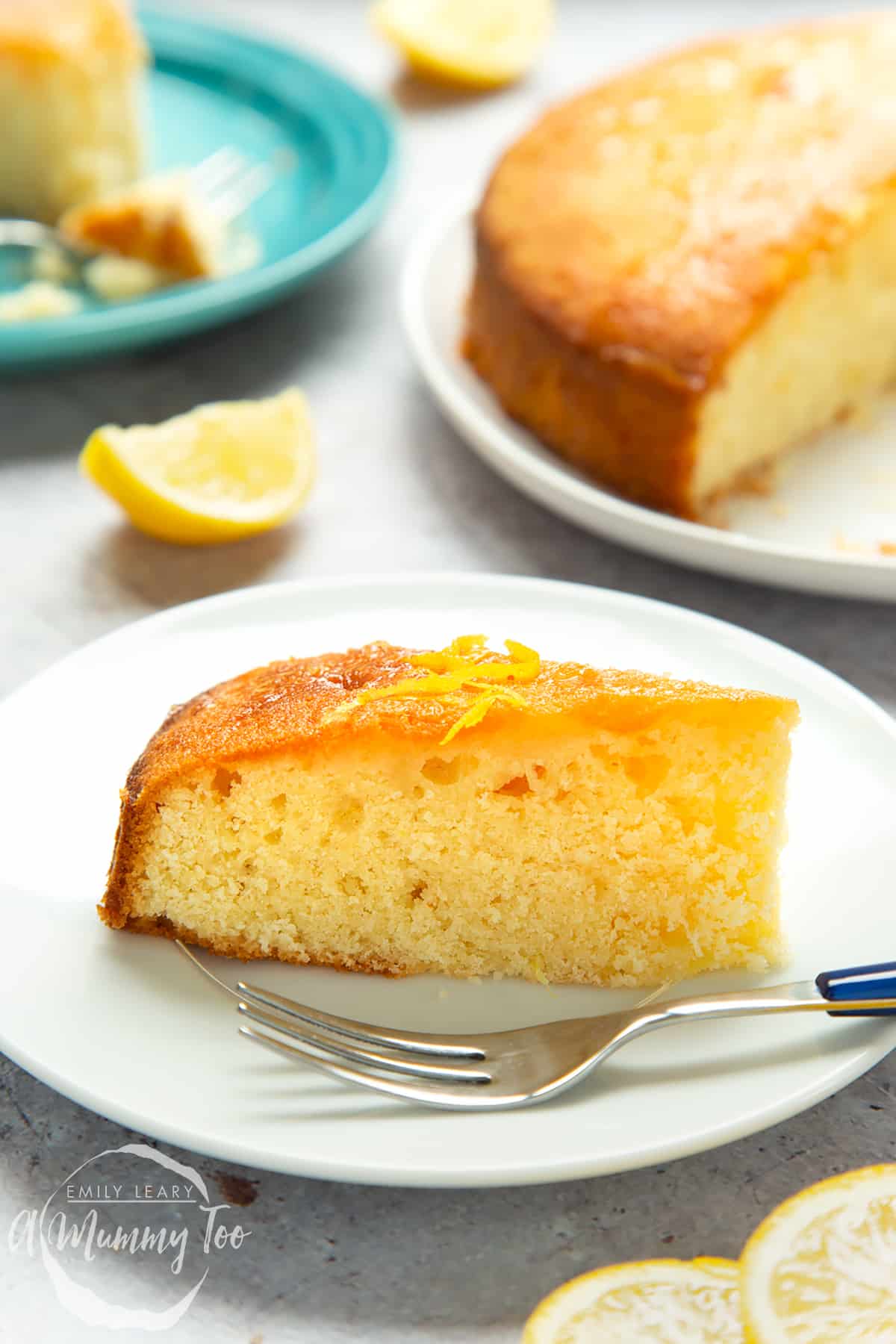
So does this lemon drizzle cake live up to its name? Actually, yes. It's exceptionally gorgeous as over 300 FIVE STAR reviews will confirm! Just have a look at the comments to see how much everyone loves this recipe.
I've been making this Great British Bake Off worthy recipe for years, ever since it was emailed over to me by lovely reader Jayne Crammond, way back in 2012! Jane explained:
I chose this recipe because I spent ages trying to find a lemon cake that was...well, lemony enough! I like my lemon cake to be very zingy and moist so I ended up taking bits of different recipes and putting them together to make this one, which is probably the one and only time I’ve been vaguely inventive in the kitchen.
- How to serve lemon drizzle cake?
- Ingredients & substitutions
- Equipment and FAQs
- Step-by-step instructions
- Allergen & Dietary Information for Lemon Drizzle Cake
- Troubleshooting Lemon Drizzle Cake
- How to store, keep & freeze lemon drizzle cake
- How to make different size and shape lemon drizzle cakes
- Print this lemon drizzle cake recipe
Where does lemon drizzle cake come from?
Lemon drizzle cake is thought to be an English invention going back at least a few hundred years! It was recently voted England's favourite cake flavour and I can see why. It’s zingy, zesty, sweet and delicious.
Lemon drizzle cake no doubt takes inspiration from classic 'pound cake' recipes (that's a cake made with a pound of flour, a pound of sugar, a pound of fat and a pound of eggs), but it’s the addition of lemon in the sponge and in the syrup added at the end that makes it really special.
An Easy One Bowl Recipe
You'll make the batter in a single large bowl with the simplest dry and wet ingredients - no need for a separate bowl at any point!
To start, you'll whisk butter and sugar together, then beat in two eggs before folding in self-raising flour.
You'll then add the zest of two lemons and the juice of one to make the batter super citrusy. Your mouth WILL water. You'll then pop the cake mixture in a tin and bake this easy lemon drizzle cake!
While your lemon drizzle cake is baking, you'll make an incredible syrup to drizzle over the top. It's as simple as just popping some icing sugar and lemon juice (yep, more lemon!) in a pan and briefly boiling to a thin syrup. When your cake comes out of the oven, you'll then skewer it all over (a cocktail stick works well too!) and then pour on the zesty, tangy lemon syrup.
The only really difficult thing with this recipe is waiting until it's cool so that you can pop it out of the tin and devour! The sticky, zesty lemon glaze top is an absolute delight.
Is lemon drizzle cake easy to make?
Yes, it's really easy to make this lovely lemon cake recipe and that's one of the reasons this traditional British cake is still so popular.
You'll make the batter in a single bowl by first whisking butter and sugar together, then adding eggs, then folding in flour. Stirring in a good helping of lemon juice and lemon zest is what makes the sponge so perfectly lemony.
Making the drizzle to spoon on top is super easy too. You'll just pop lemon juice and icing sugar in a pan and heat until you have a thin syrup. Once your cake is baked, you'll skewer holes all over the top and pour on the lemon drizzle syrup before allowing to cool. It's that simple!
Are you ready to enjoy a soft, butter, melt-in-the mouth lemon drizzle cake? Here's what to do to make this traditional, British dessert and find out why it's my favorite cake of all time.
How to serve lemon drizzle cake?
My personal preference for enjoying a slice of lemon drizzle cake is with a big mug of tea!
For me, I don’t need anything else to accompany my lemon drizzle: the moistness and sweetness of the sponge is all you need on your plate.
However, if you want to add a little something extra when serving, then vanilla ice cream or whipped cream are both delicious additions too, lending a creaminess to offset the zing of the lemon drizzle.
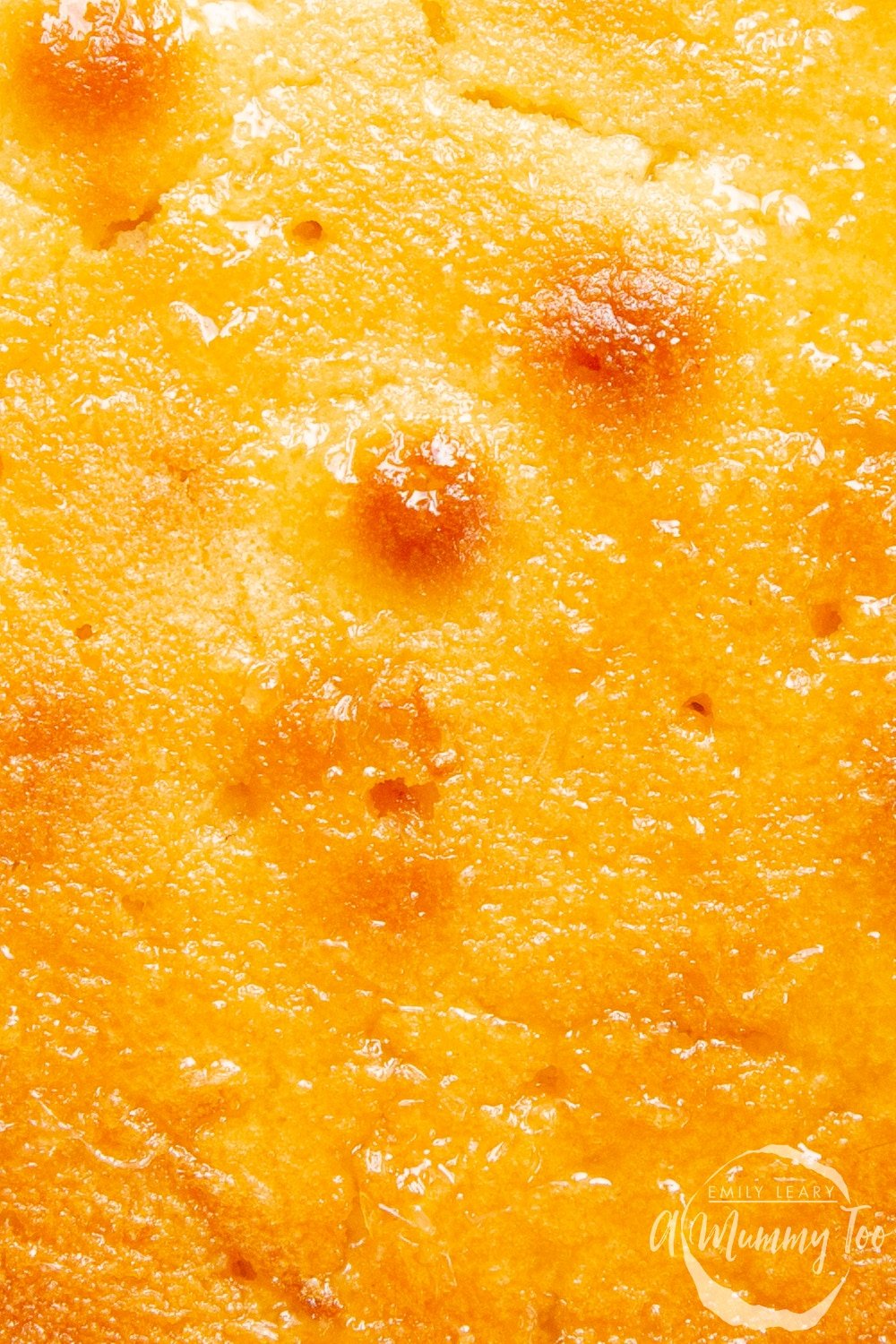
Ingredients & substitutions
- 170 g (⅔+¼ cup) white caster sugar (superfine sugar)
- 170 g (1½ sticks) slightly salted butter
- 2 medium free range eggs
- 170 g (1 cup + 3 tbsp) self-raising white flour (self rising flour) sifted
- 3 unwaxed lemons (A standard UK lemon gives about 2 tbsp of juice. If yours are larger, adjust accordingly)
- 4 tbsp icing sugar (powdered sugar)
Learn more about
Lemons
Does it matter what kind of lemons I use?
You can use any type of lemons you like in this lemon drizzle cake but they should be unwaxed as you'll be zesting them.
If you can't get hold of unwaxed lemons, you can remove the wax at home. Just place your lemons in a colander in the sink and pour freshly boiled water all over them. While they're still warm, but not too hot to handle, brush them gently with a vegetable brush and the wax should come away. You can then rinse them off and they'll be ready to use.
Remember, too, that lemons are truly the star of the show in this recipe, so while standard lemons are absolutely fine to use and give a wonderful result, investing in good quality lemons will make the cake extra special.
Note: lemons can vary in size and therefore give different amounts of juice. A standard UK lemon, as used in this recipe, gives about 2 tbsp of juice. If yours are larger or smaller, adjust accordingly.
How can I tell if my lemons have gone bad?
Generally speaking, a great way to tell if any food has gone off, is to trust your senses and lemons are no exception.
First, look at your lemon. It should have a bright, firm, slightly shiny yellow skin.
If the skin looks shrivelled, hardened or dry, then the lemon may be past its best, but the juice inside could still be good.
If you can see any powdery substance or mould on the outside of your lemon, then it should be discarded immediately.
If your lemon looks fine, then move on to the squeeze test. Your lemon should feel firm and a little bouncy when squeezed. If it's very hard or collapses, it's no good.
Happy with the look and feel? Cut your lemon open.
If everything looks normal, it's time to use your sense of smell. Does it smell like a good fresh lemon or is something not quite right?
If there is anything unusual about the smell, throw them away. If it smells good, you're probably in the clear, but you can always taste some of the juice as a final test.
Uncut lemons brought home from the supermarket should last 1-2 weeks if left on the counter or in the fruit bowl. However, they can last up to two months in the refrigerator, so I would always recommend storing them in your crisper drawer.
Once you have cut a lemon open, it will go bad much more quickly. If you have any cut lemon leftover, you should wrap it well and put it straight into the fridge where it should keep for 2-3 days.
Don't use a lemon that you've left out on the counter for over a couple of hours after cutting.
Can I use lemon extract instead?
I've only tested this recipe with fresh lemons and the juice and zest are quite important to getting that ideal flavour and texture, but you could certainly try leaving out the lemon zest and juice in the sponge and using a little lemon extract instead.
For the drizzle, you could use 4 tbsp icing sugar, 4 tbsp / 2 fl oz of water and a little lemon extract to give a lemon syrup. Again, I haven't tested this so can't be sure how well it would work.
Why did my cake taste bitter?
When you zest your lemons, you should make sure to only take the yellow part of the lemon skin. I tend to use a fine grater for this (such as a microplane) and it does the job beautifully.
If you use a vegetable peeler, you'll probably find the the pieces of lemon peel are too large and that you have taken off some of the pith as well, which is the white part underneath the zest. This is very bitter and can make your final cake taste unpleasant.
Can I leave out the lemon out of this lemon drizzle cake?
You can leave out the lemon, but you’ll want to replace it with something else - try using the juice and zest of an orange instead. I have an amazing orange drizzle cake you could try.
If you’re nervous about this cake being too lemony, just be sure to taste the syrup before you pour it over the cake.
Some lemons are zingier than others, and personal taste varies, so if you want to tone it done, just add a little more sugar, or use less of the syrup. Personally, I like an intense lemony flavor and that's what this recipe is designed to deliver.
Eggs
Can I use large eggs instead of medium eggs?
In the UK, medium eggs eggs weigh 53g - 63g (1.9oz - 2.2oz) and large eggs typically weigh 63g - 73g (2.2oz - 2.6 oz) .
If you want to use large eggs, beat them separately, then weigh 125g (4.4oz) into your cake bowl.
Can I make this lemon drizzle cake without eggs?
The eggs are an important part of this recipe. They not only add moisture and colour, they also help to bind the different ingredients together.
If you can’t use eggs in this recipe, the following options can be considered as a replacement:
Egg alternatives (each = 1 egg so multiply as needed for the recipe)
- Store-bought egg replacement powder (use as directed on the packet).
- 1 tablespoon of crushed chia or flax seeds mixed with 2 tablespoons of water and left for 10 minutes in the fridge.
- 3 tablespoons of aquafaba.
- 3 tablespoons of applesauce.
- Half of a medium sized banana, mashed. It's best to use fairly ripe bananas for this as they will mash more easily and bind your ingredients together more effectively
Note: I have not tested all of these replacements, so let me know how you get on.
Butter
Can I make this lemon drizzle cake without butter?
If you don’t want to use butter in this lemon drizzle cake, you can substitute for the same amount of flavourless oil, standard margarine or Stork.
If you do, it’s really important to choose a margarine with a high fat content, ideally around 80%. Light margarines tend to have a high water content which can upset the balance of the batter, thus affecting the final bake.
Remember, I always make this cake with butter, so you might need to test a little to be sure you're using just the right amount of your fat of choice.
Flour
Can I make this lemon drizzle cake with plain flour?
You’re going to want this lemon drizzle cake to rise, so you’re going to need a raising agent, and there isn’t anything to help with rise in plain flour. In contrast, self-raising flour contains baking powder, which helps give a lovely light, airy sponge and a good rise.
If you don't have any self-raising flour, you can make your own. Simply add two teaspoons of baking powder to every 150g (1 cup) of plain flour in a bowl and sift them together before using in your recipe.
This particular recipe uses 170g (1 cup + 3 tbsp) self-raising flour, so if you use plain flour instead, you’ll need to add about 2 ¼ tsp of baking powder.
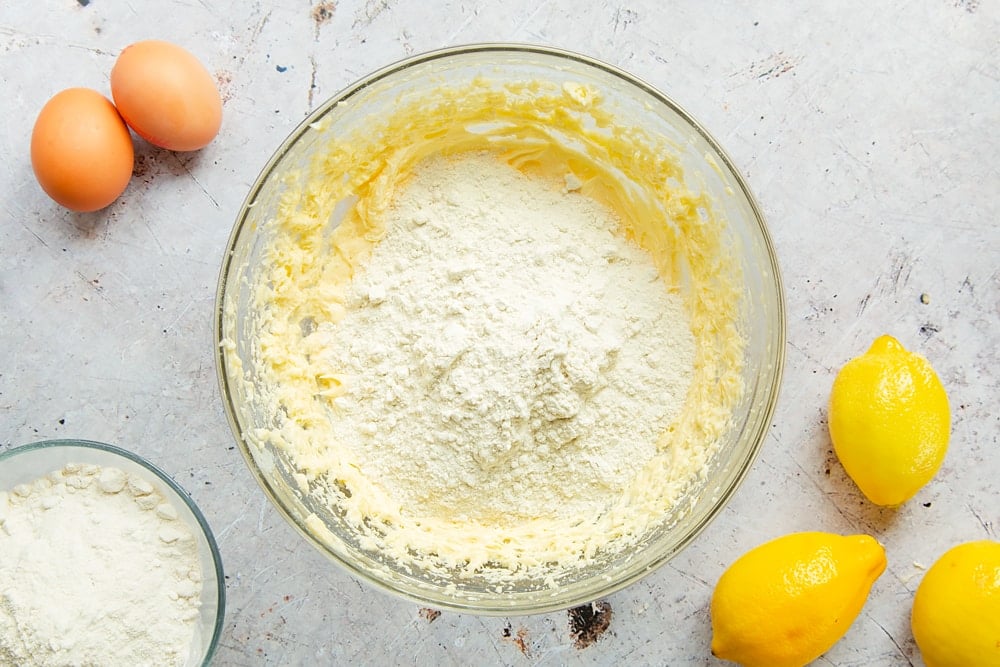
Sugar
Do I have to use caster sugar in this recipe?
I know that caster sugar isn’t something that’s easily available in the US - don’t worry.
Caster sugar crystals are very small which helps them to dissolve more easily, but granulated sugar, golden caster sugar and brown sugar will all work, they’ll just give a slightly different texture.
Do not use icing sugar / powdered sugar in this recipe as the crystals are too fine.
Can I make this lemon drizzle cake recipe without sugar?
Sugar lends not only sweetness, but also structure and texture to the cake, so I wouldn’t recommend leaving it out.
I have not experimented with artificial sweeteners, but I suspect it would be tricky to balance the lemon out - let me know if you experiment with it.
Can I make the lemon drizzle syrup without icing sugar?
Icing sugar is another name for powdered sugar.
If you don’t have any, you can use granulated or caster sugar, you will just need to be patient as you warm the syrup as it will take longer for the sugar crystals to fully dissolve.
Can I make the lemon drizzle cake topping crunchy?
If you want a really crunchy lemon drizzle topping instead of a syrup that sinks in, you’ll need to change the method slightly.
Use granulated sugar instead of icing sugar and without any heat, mix your lemon juice and sugar together to form a paste, then spread over the warm cake with the back of a spoon. This should give you your zesty crunchy topping once cooled.
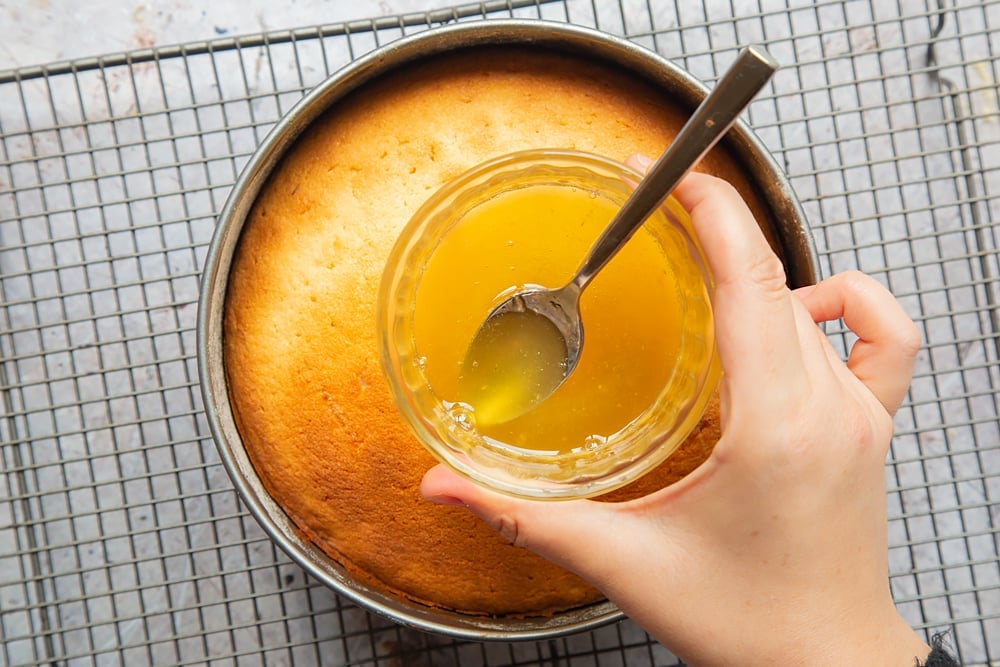
When should I drizzle my cake?
It's best to drizzle the syrup over the cake while it's still warm. The main reason for this is that it will penetrate the cake more evenly make for a better texture.
Leave the cake in the tin while you do this so that you don’t lose any of the syrup as it seeps through the cake.
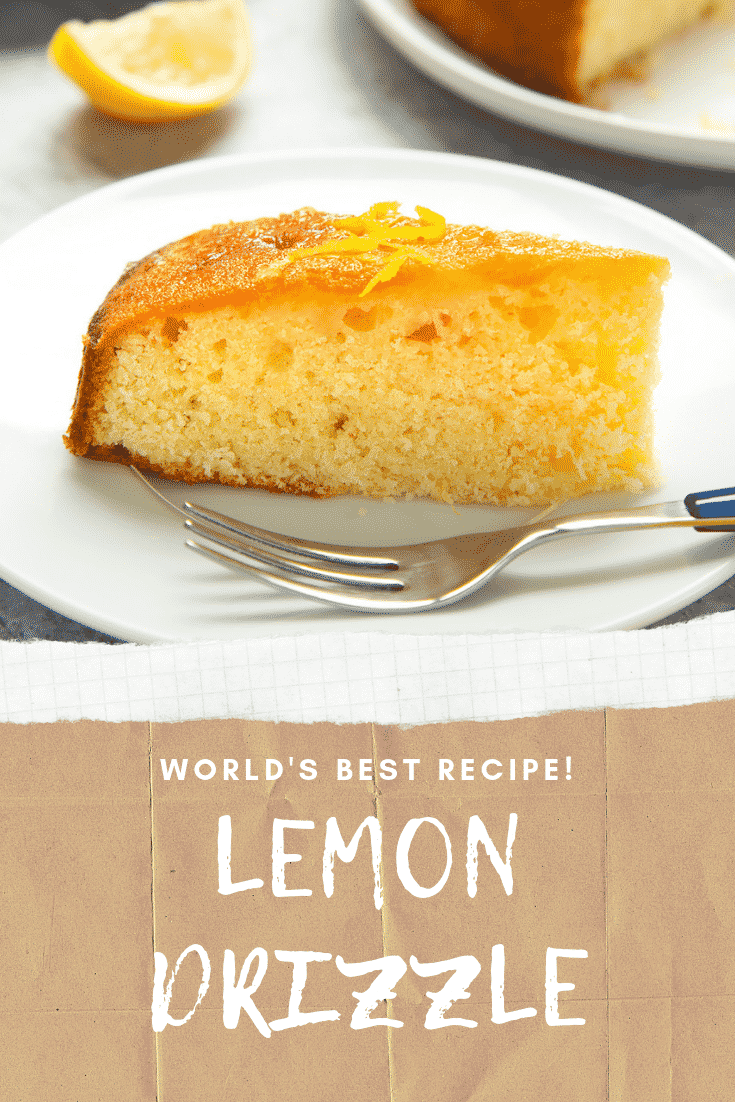
Equipment and FAQs
- Wooden spoon or silicone spatula
- Round 20cm (8") nonstick cake tin or larger up to 23cm (9") for a thinner cake.
- Do I need special equipment to make this lemon drizzle cake?
- Can I make this lemon drizzle cake in a food processor or stand mixer?
- Can I make this lemon drizzle cake without an electric whisk?
- Can I make this lemon drizzle cake using the all in one method?
- Can I make this lemon drizzle without weighing scales?
- Do I need to use a wide tin? Can I use a smaller or bigger tin?
Do I need special equipment to make this lemon drizzle cake?
You don’t need any specialist equipment to make this lemon drizzle cake.
The only thing you might not already have is a springform tin - that is, a tin with a loose bottom and a clip on the side to make it super easy to get your cake out of the tin cleanly.
If you don’t want to invest in a springform tin, a loose-bottomed one will do the job.
You could just turn your cooled cake out onto the wire rack - as long as the tin is properly lined, it should come out easily - just be very careful as the cooled syrup will make the top of the cake delicate and sticky.
Alternatively, try laying an extra two strips of baking paper in a cross in your tin before you line it to create four tabs long tabs that go up past the sides of the cake tin. This will allow you to lift the sponges out once cool.
Can I make this lemon drizzle cake in a food processor or stand mixer?
You can use a stand-type electric mixer, but it’s not really necessary.
If your food processor comes with a beater rather than blade attachment, then you cream the butter and sugar together on a low setting, then blend in the eggs. It won’t incorporate as much air as a whisk, though, so is not recommended.
You can definitely beat the butter and sugar, and then the eggs, in a stand mixer to speed up the job, but a hand mixer will do the job just as well.
Whatever method you use to combine the butter, sugar and eggs, it’s important that you gently fold the flour in by hand. Beating will cause the cake batter can be easily overworked, which could make your finished bake tough and/or poorly risen if the blades knock out the air and stretch the gluten.
Can I make this lemon drizzle cake without an electric whisk?
Using an electric hand whisk to beat the butter and sugar together, and then beat in the eggs is really handy because it gets the job done and beats in lots of air.
However, you can absolutely do the job by hand, it’ll just take a little more elbow grease!
Can I make this lemon drizzle cake using the all in one method?
The all in one method is where you add all of the sponge ingredients into the bowl at once and then beat them all together until smooth.
This recipe is quite forgiving, so if you are in a hurry, the all in-one method will work.
However, I recommend following the recipe and beating the butter and sugar first, then adding the eggs, then folding in the flour etc as this will incorporate plenty of air without overworking the gluten in your mixture, which can make for a tough sponge.
Can I make this lemon drizzle without weighing scales?
The best bakes happen when you take the time to measure everything out properly. When I follow a recipe, it’s the first thing I do. That way, I know I have the right quantities of everything.
I’ve provided the ingredient measurements in both metric and common US measures like cups and sticks for ease.
Do I need to use a wide tin? Can I use a smaller or bigger tin?
I like a wide cake tin as it gives a shallow cake that can absorb lots of syrup deep into the sponge but you can use any size tin you like, just bear in mind that it will affect the cooking time. If you're using a 23cm (9 inch) tin, your cake will probably take around 25 minutes. A 18cm (7 inch) tin may take around 30 minutes, while a very small tin which makes the batter much deeper might take up to an hour.
You might even like to try make lemon cakes like this in bundt pans, but you would need to experiment with size and quantities to ensure good results. I would recommend getting a wax cake release spray if you're using bundt tins as they are more prone to sticking.
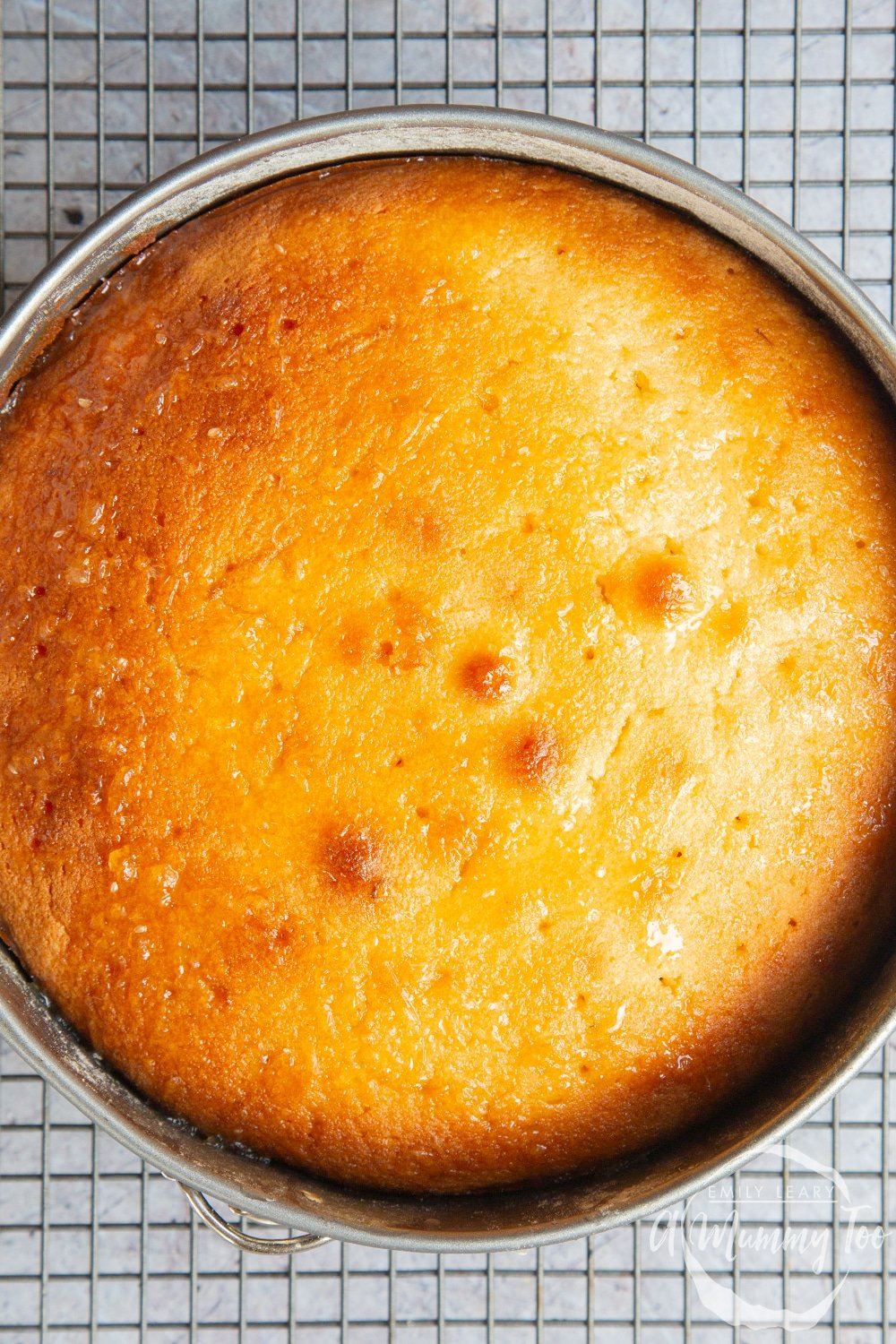
Step-by-step instructions
Grease and line your nonstick cake tin. If you don't have any greaseproof paper / parchment paper, greasing and then dusting with flour can help prevent sticking. Some swear by a caster sugar and flour mixture for dusting - it's up to you!
Preheat the oven to 180C (160C fan, 350F). Weigh the sugar and butter into a large mixing bowl.
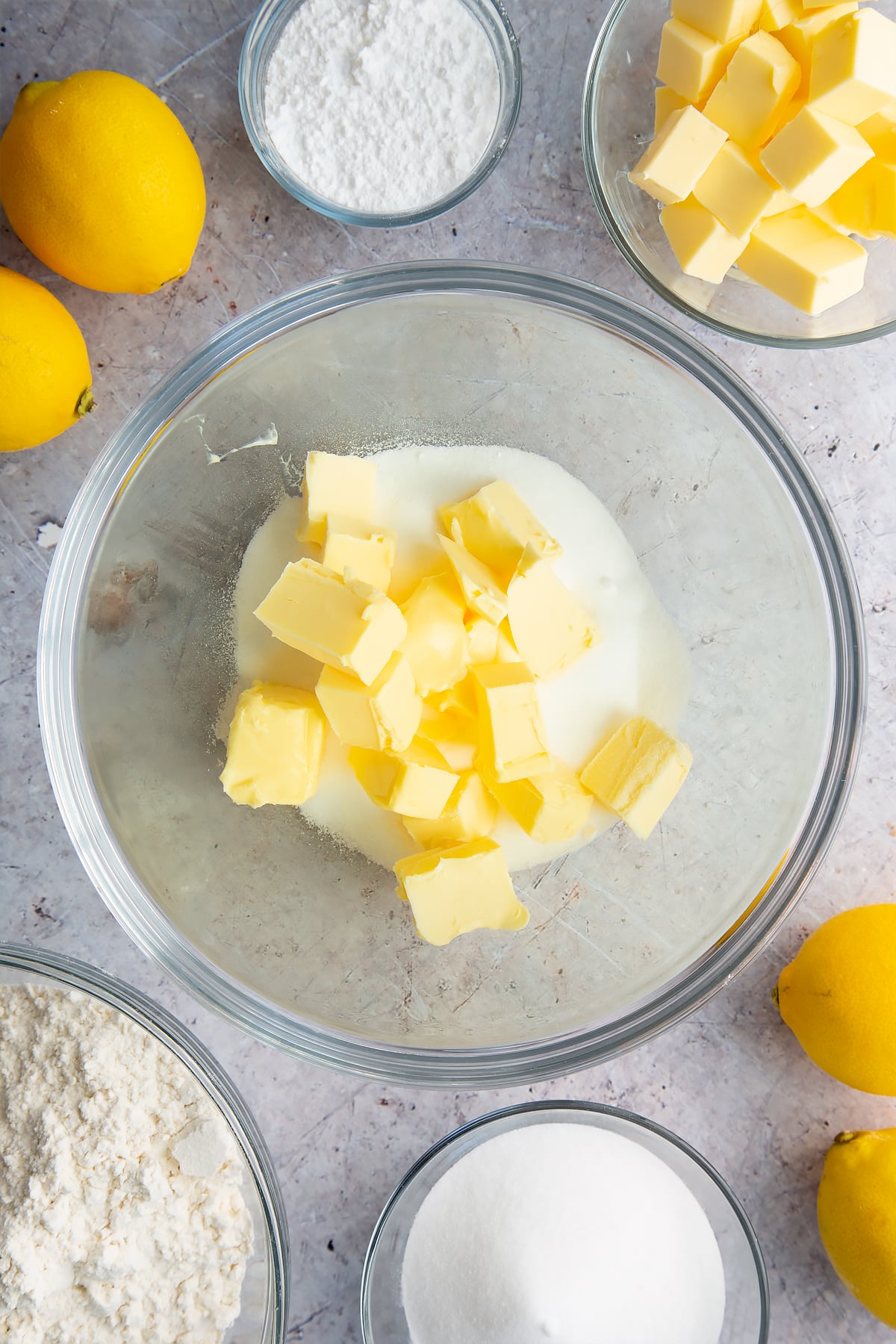
Beat together until fluffy.
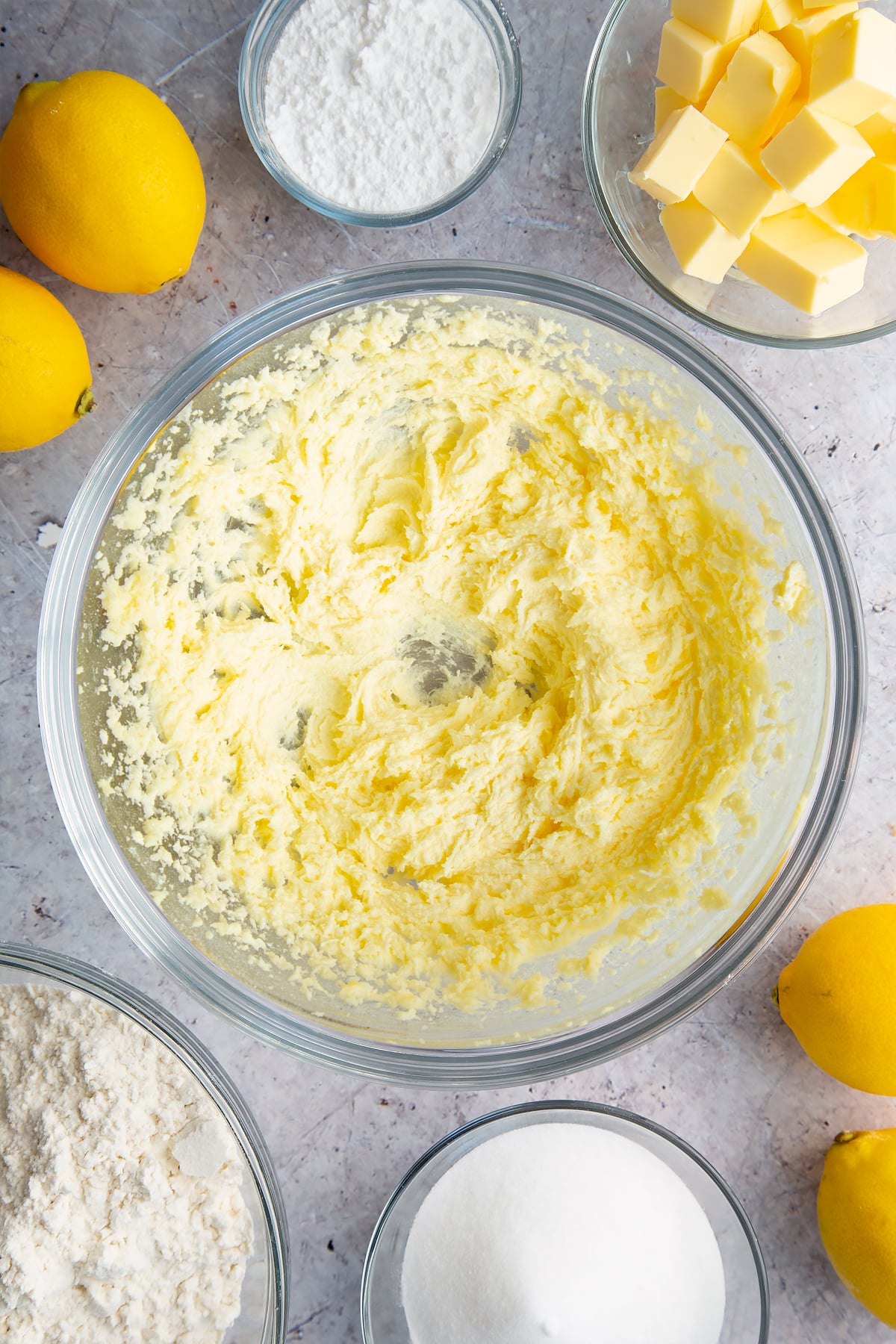
Add both eggs.
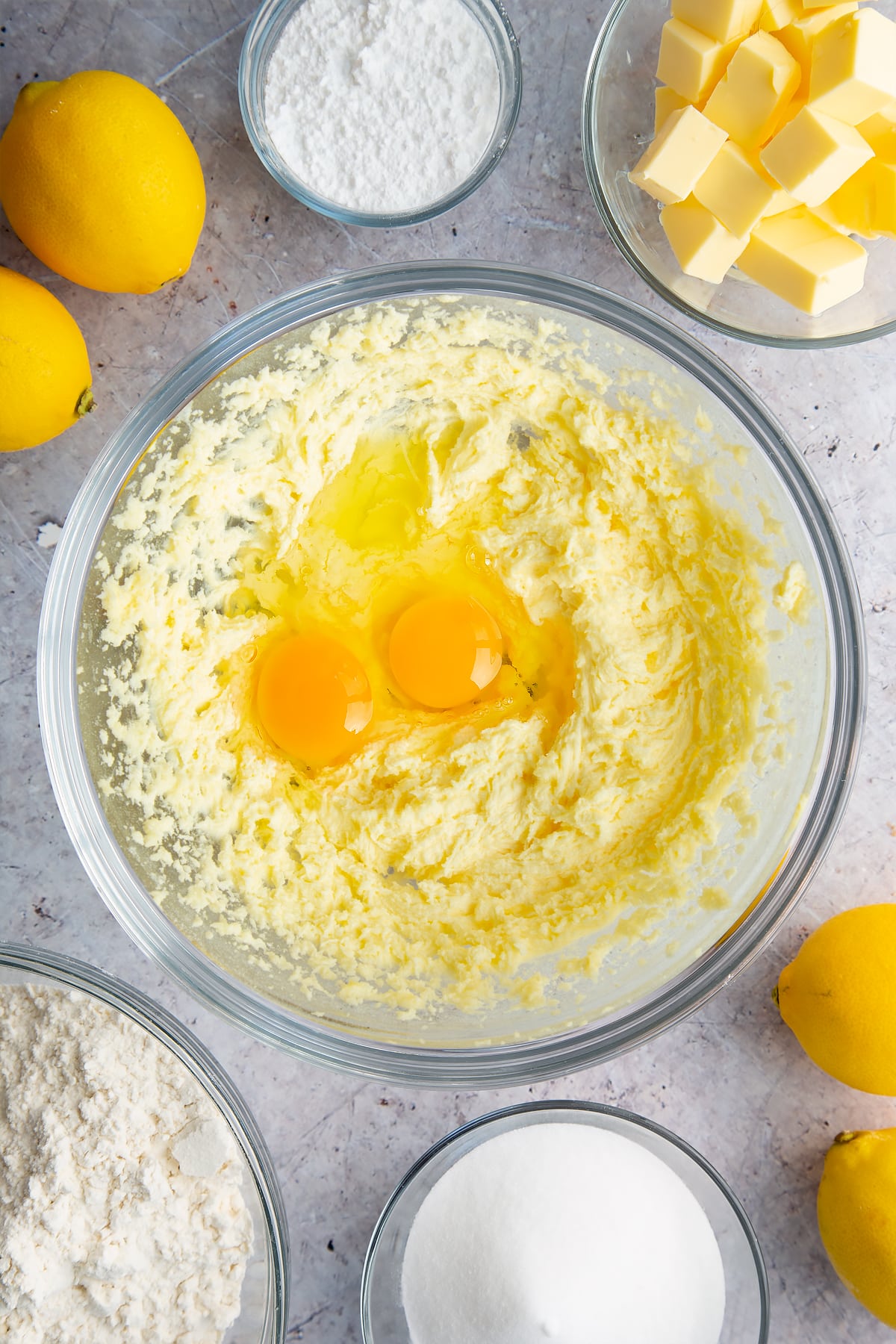
Whisk through.
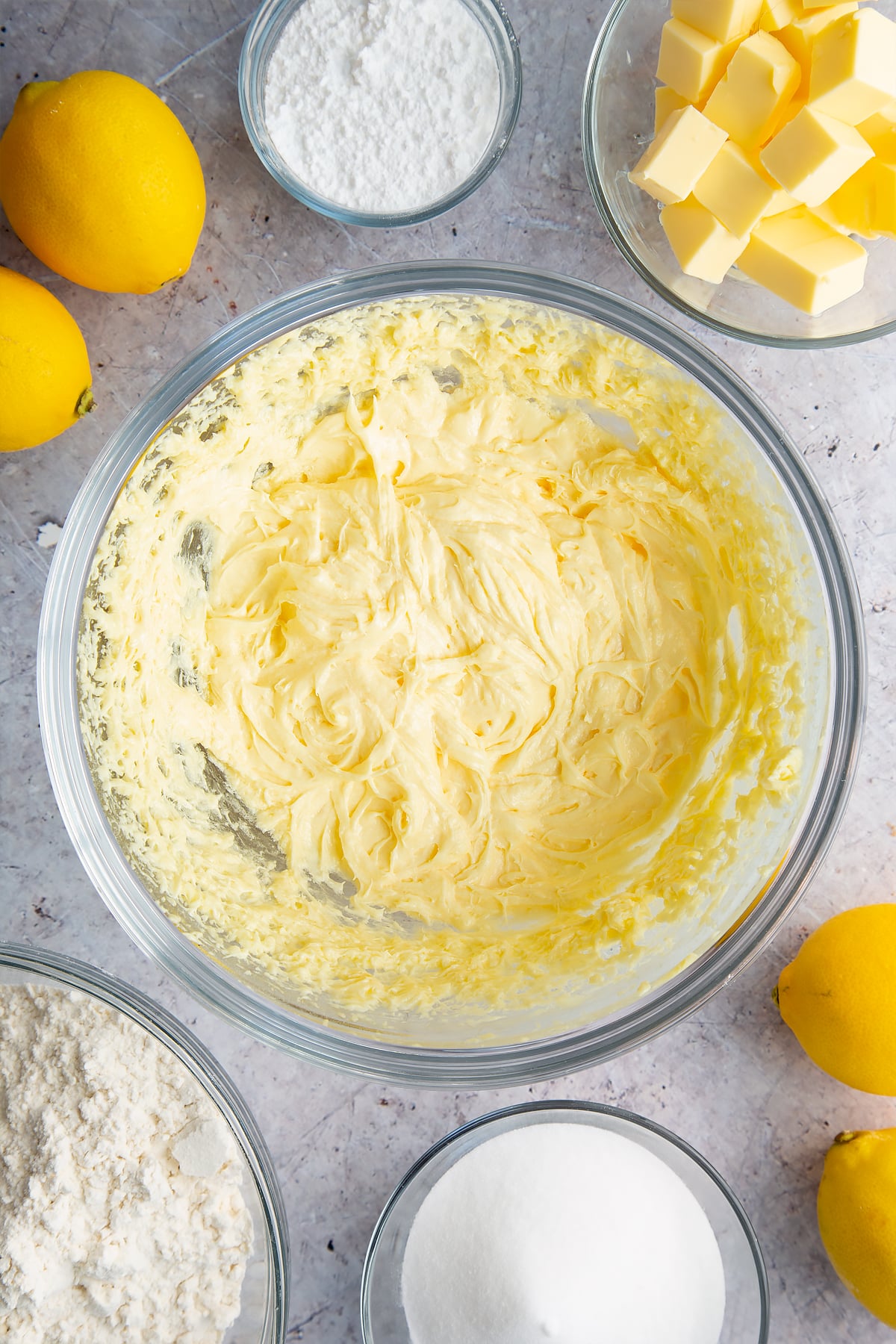
Add the sifted flour - the last of the dry ingredients.
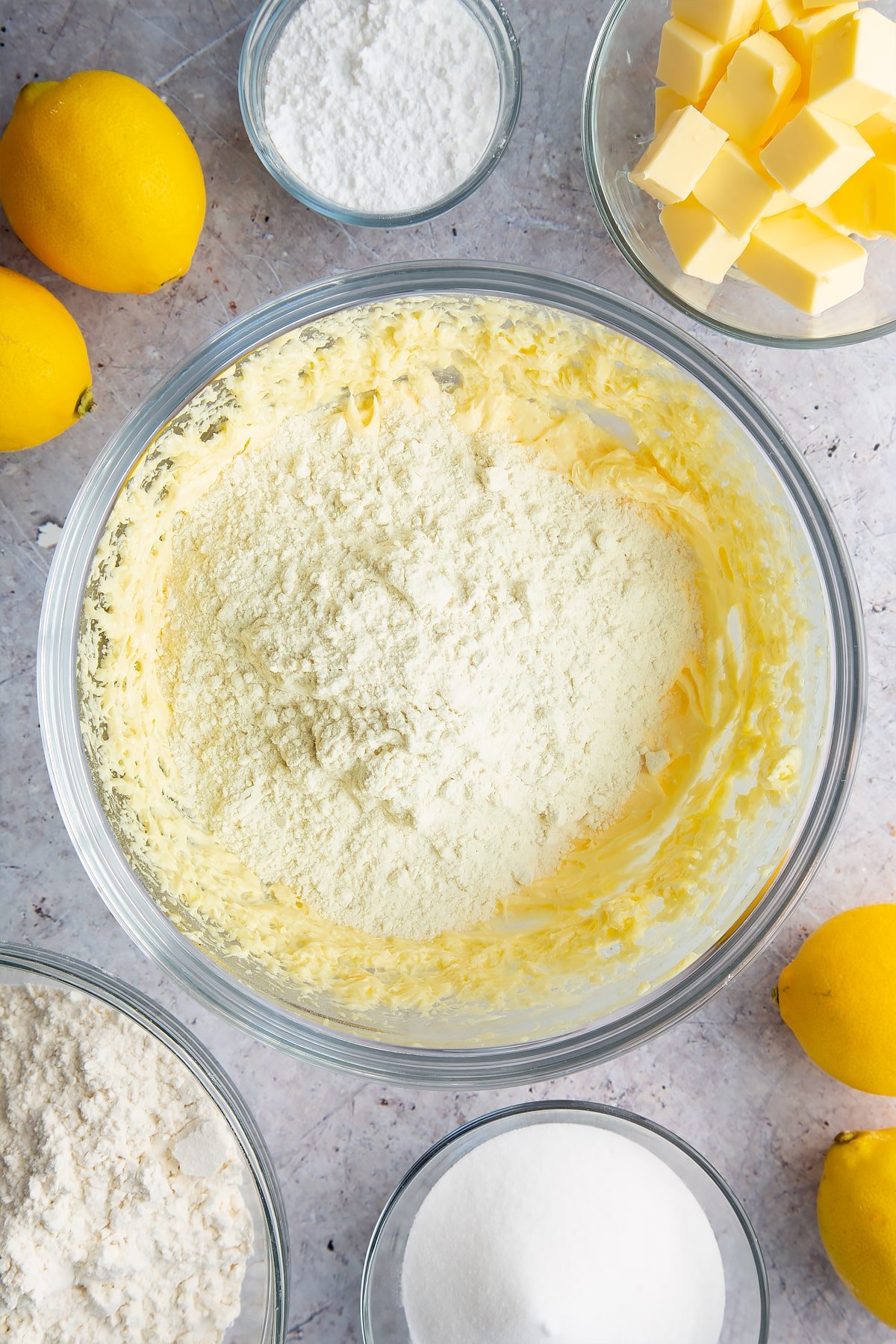
Fold until smooth.
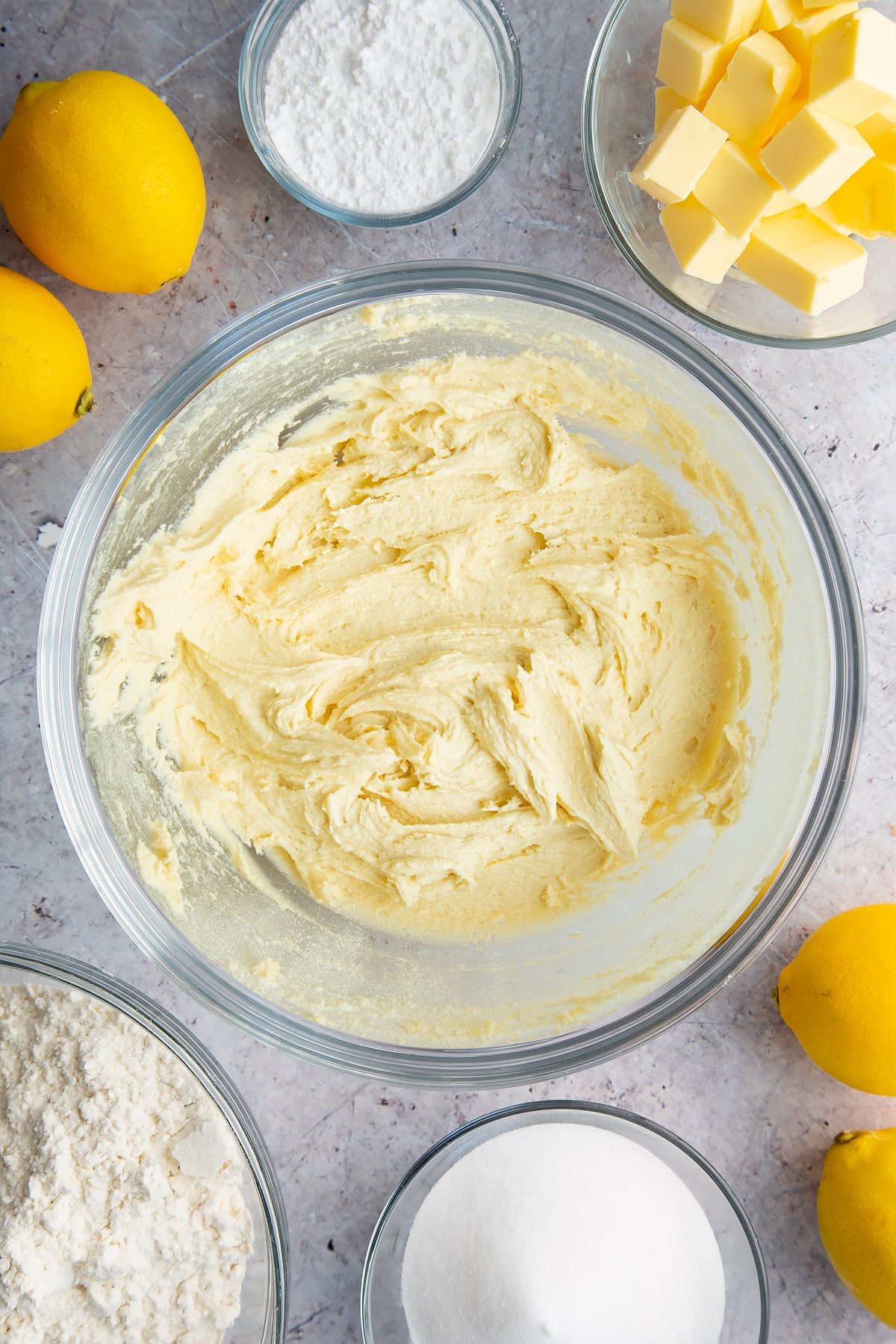
Add the zest of two lemons and the juice of one to the mixture.
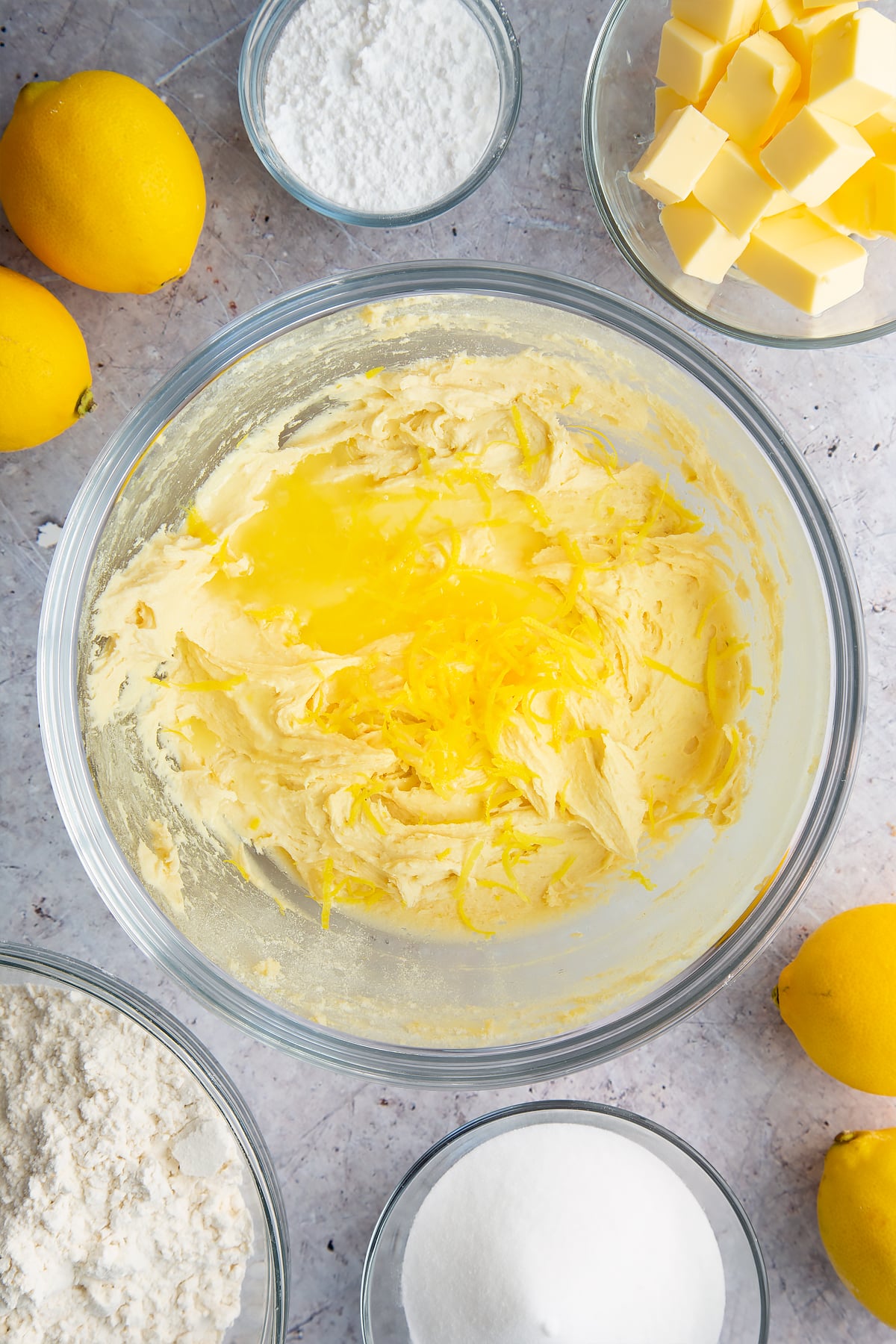
Gently stir through.
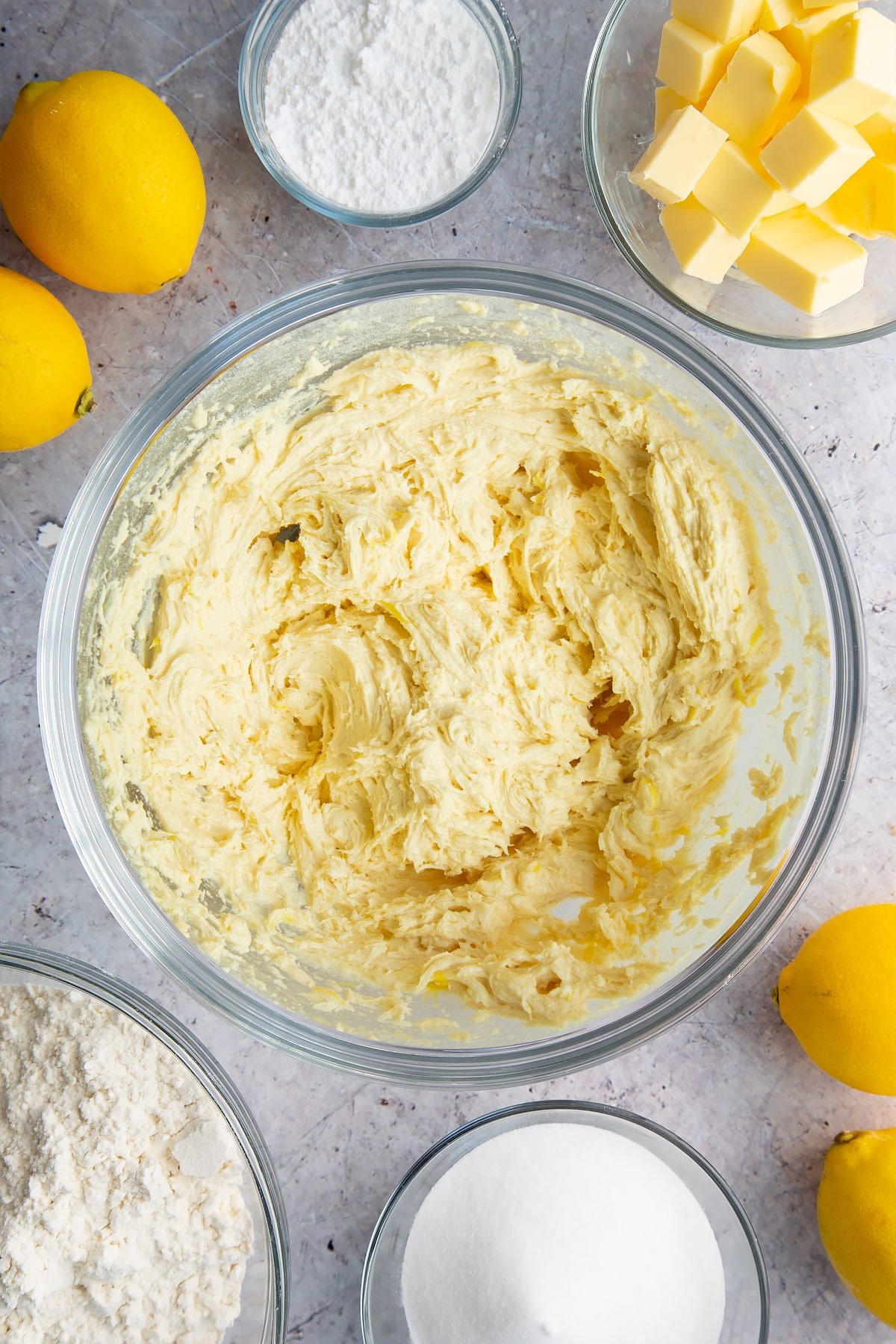
Spoon the batter into the prepared cake tin. I recommend using a loose-bottomed springform tin as it makes it super easy to get your cake out of the tin cleanly.
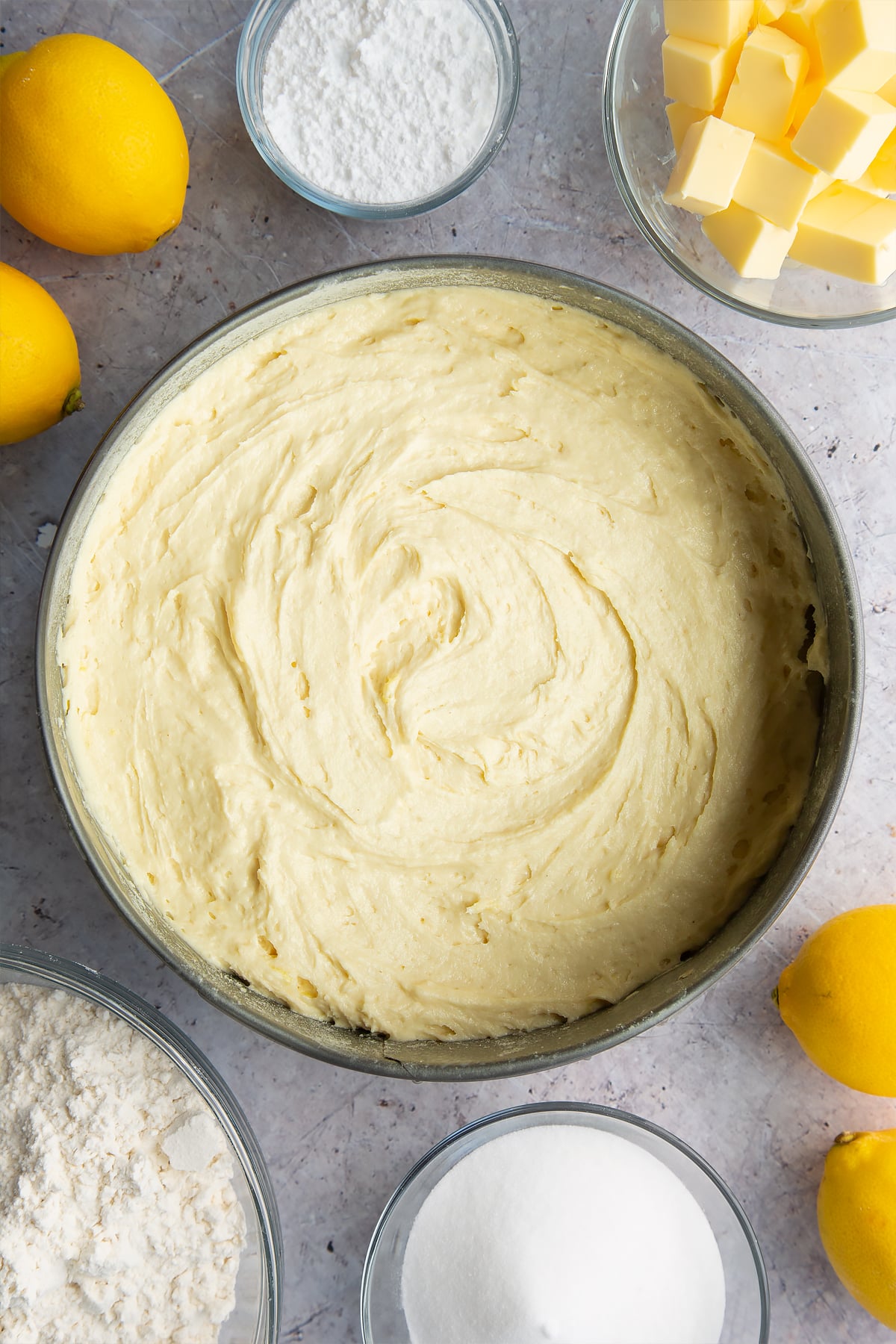
Note: I'm using a 23cm (9 inch) tin in these images, which is a wide tin, meaning your cake will be quite shallow. I like this as it means the sponge can absorb lots of syrup all the way through when we add it later. But if you want a narrower, taller cake, that's fine. In the video, I've used an 18cm (7 inch) tin. See the tips section below for more advice on adjusting the cooking times.
Bake in your preheated oven for 25-30 minutes - the wider the tin, the shorter the cooking time. The lemon sponge should be golden on the outside and a skewer pushed into the center of the cake should come out clean - keep an eye on it as you don't want it to over-bake.
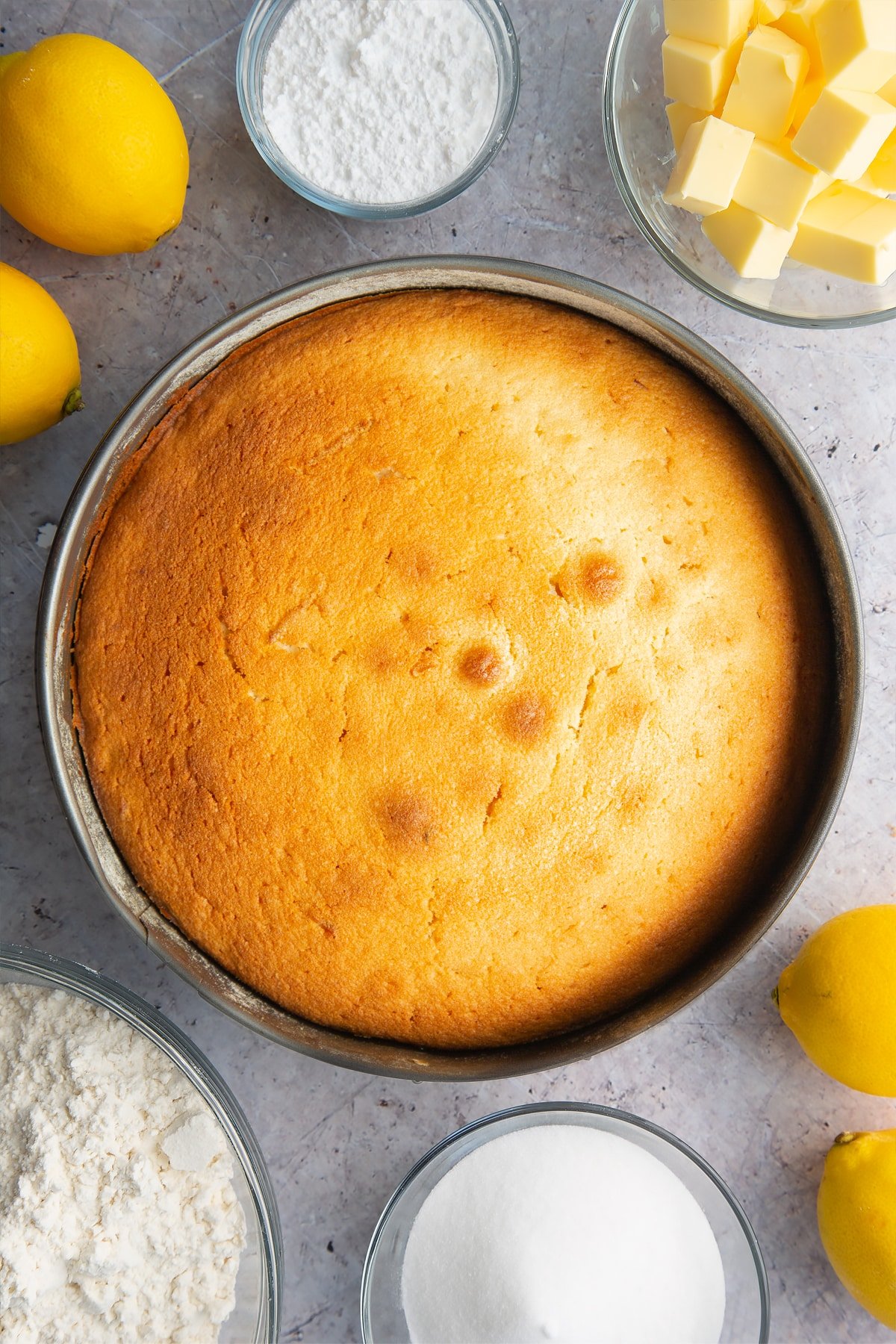
To make the syrup, in a small saucepan, mix the juice of two of the lemons with the icing sugar.
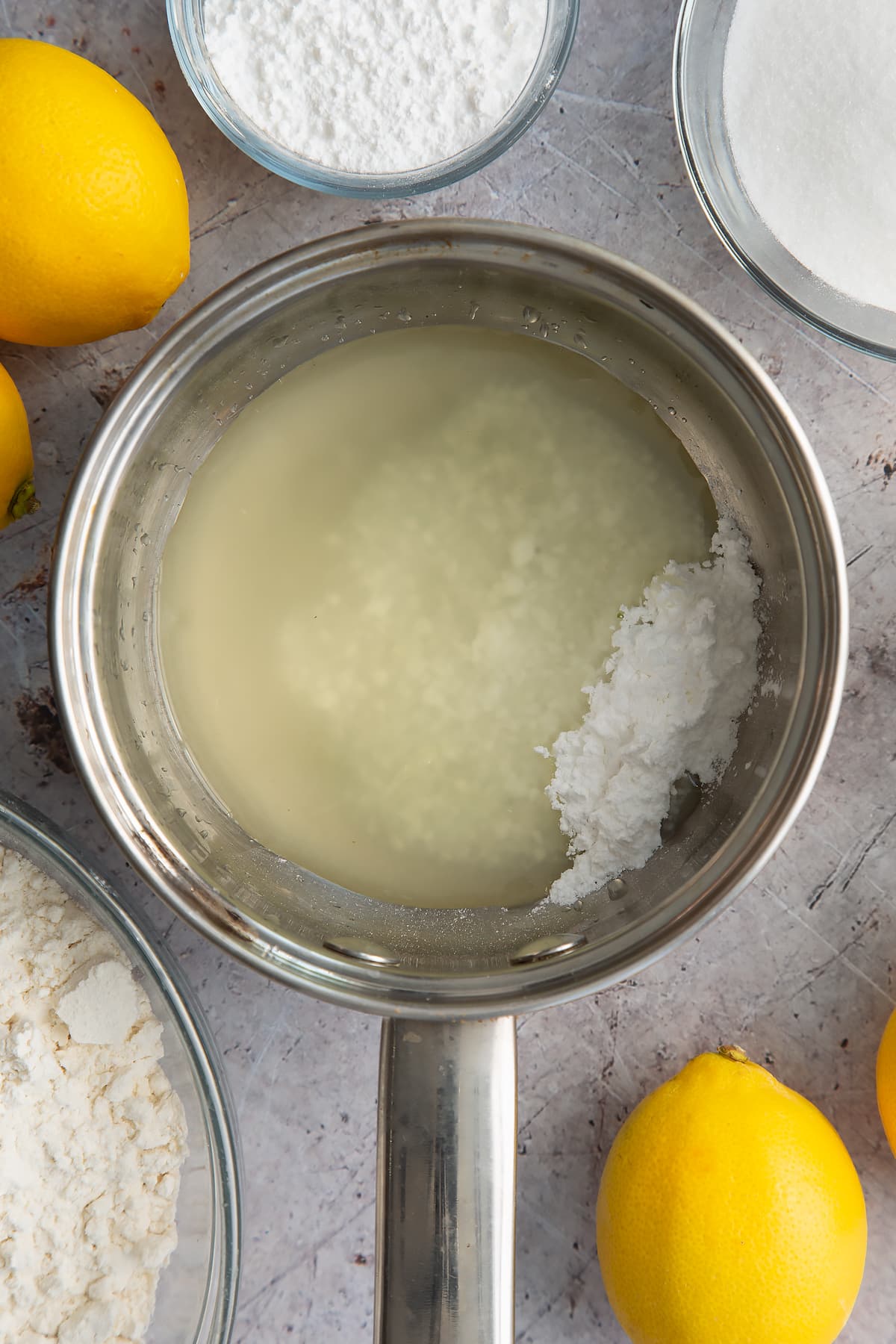
Place over a medium low heat and stir until the sugar has dissolved, then bring to a boil for 1-2 minutes until you have a light syrupy texture.
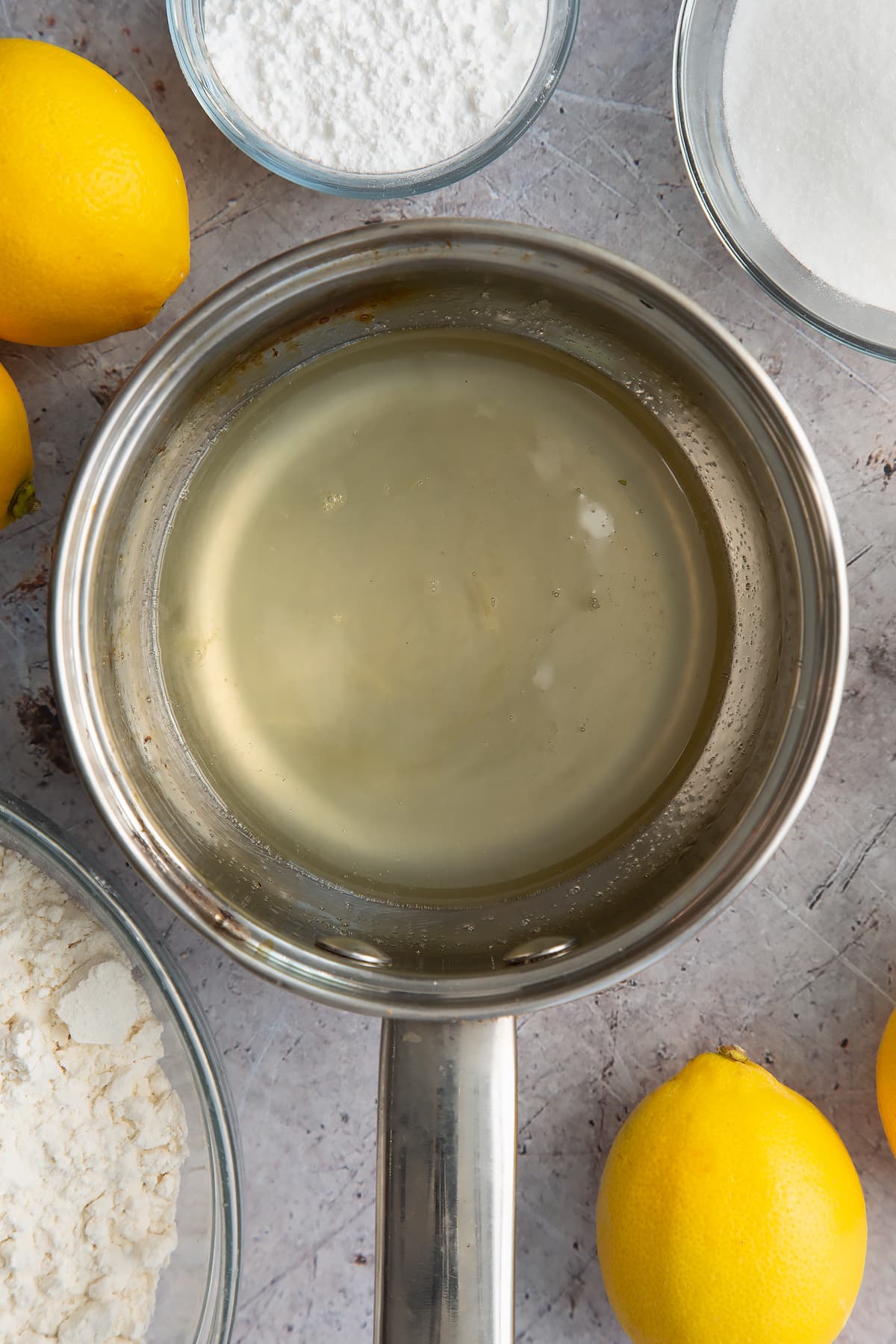
Poke holes all over the warm sponge with a skewer, almost down to the bottom.
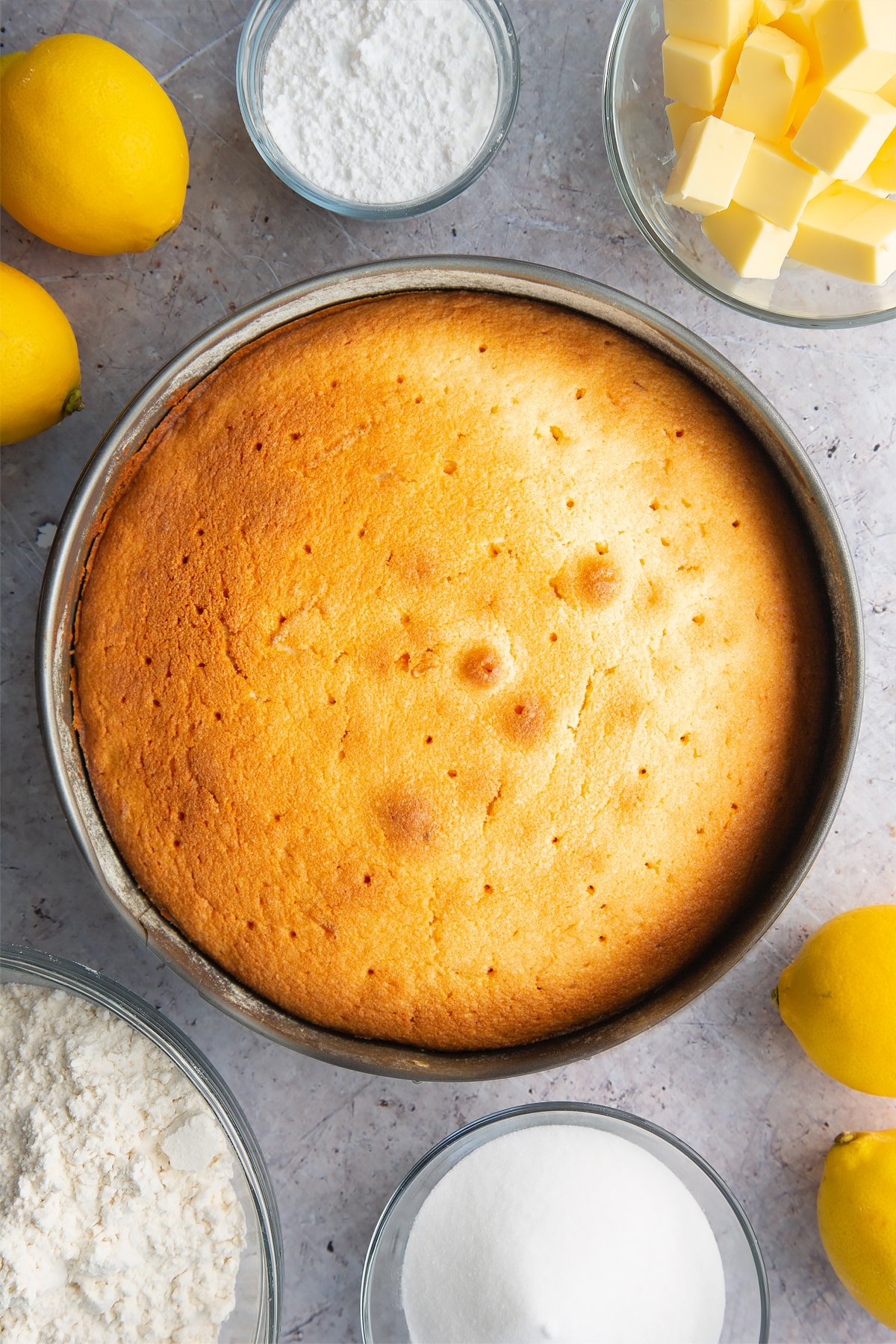
Take the syrup off the heat (careful, it's hot!) and pour all over the cooling sponge.
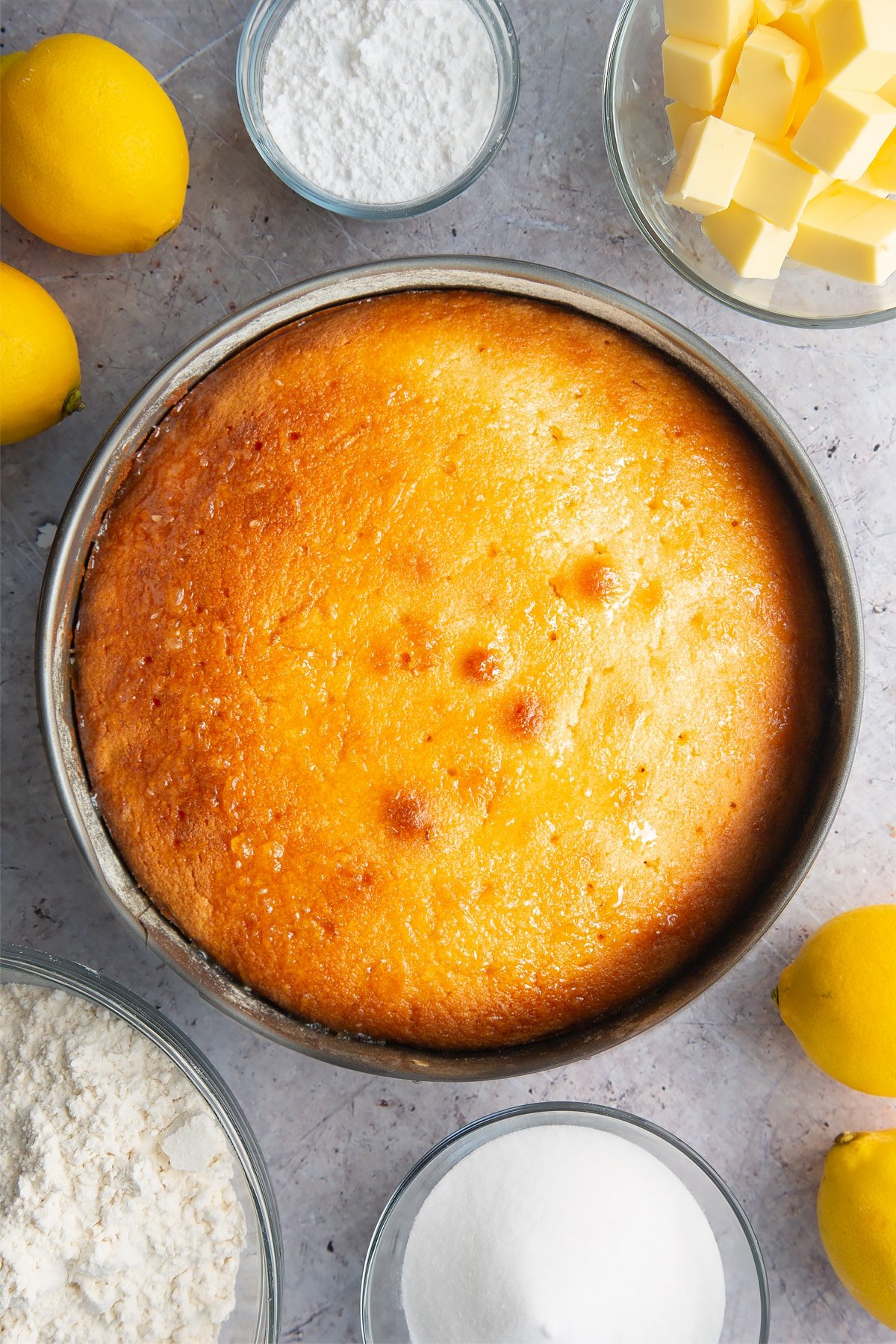
Allow the hot cake to cool, then remove from the tin and cut into generous slices. This cake has quite a delicate crumb, so be sure to let it cool completely before serving.
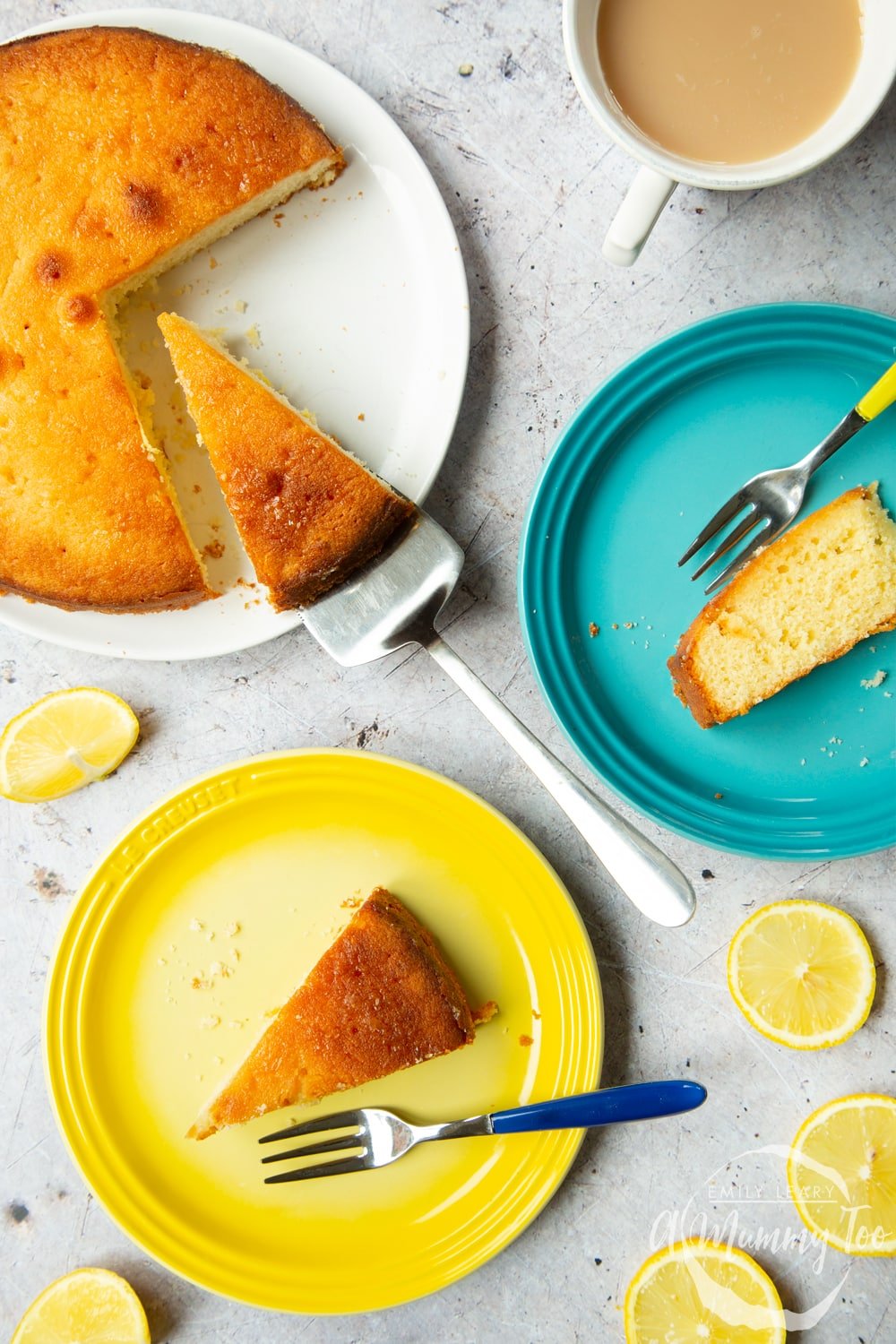
The result is a light, firm sponge that's wonderfully lemony. Perfect.
Enjoy with a hot cup of tea or coffee and savour this beautifully moist cake right down to the last slice.
This lemon drizzle really is a perfect cake - no wonder Brits consider it a total classic!

Allergen & Dietary Information for Lemon Drizzle Cake
Is this lemon drizzle cake healthy?
This cake is quite high in sugar and fat. It’s best enjoyed as an occasional treat, as part of a balanced diet.
Vegetarian lemon drizzle cake
Yes, this recipe is suitable for vegetarians as it contains no meat, fish or poultry.
Double check all of your ingredients labels to make sure to check that they are suitable for vegetarians. Don't forget to also check anything extra you intend to serve the recipe with.
How to make this lemon drizzle cake recipe vegan
No, this lemon drizzle cake is not vegan due to the use of eggs and butter, but if you want to substitute those for alternatives, I have included advice above.
For the butter, you can use any good quality vegan butter. Aim for one that is about 80% fat is possible, as this will behave similarly to dairy butter and give the best result, generally speaking.
To replace the eggs, you could try one of these alternatives (each = 1 egg so multiply as needed for the recipe):
- Store-bought egg replacement powder (use as directed on the packet).
- 1 tablespoon of crushed chia or flax seeds mixed with 2 tablespoons of water and left for 10 minutes in the fridge.
- 3 tablespoons of aquafaba.
- 3 tablespoons of applesauce.
- Half of a medium sized banana, mashed. It's best to use fairly ripe bananas for this as they will mash more easily and bind your ingredients together more effectively
Note: I have not tested all of these replacements, so let me know how you get on.
If you already have a favourite vegan victoria sponge recipe, you could try using that in place of the main batter ingredients here, simply adding the lemon zest and juice as directed and then following the steps for the drizzle.
Double check all of your ingredients labels to make sure to check that they are suitable for vegans. Don't forget to also check anything extra you intend to serve the recipe with.
Is this lemon drizzle cake recipe nut-free?
Yes, this lemon drizzle cake is totally nut-free.
However, with all allergies and sensitivities, it’s important to check the packaging of all of the ingredients you use very carefully to ensure they are nut-free.
This is because even though none of the ingredients should naturally contain nuts, some may have been produced in a factory that handles nuts, meaning there is a risk of cross-contamination.
Is this lemon drizzle cake recipe gluten-free?
No, this is not a gluten-free lemon drizzle cake as it contains wheat flour.
I haven't tried making this recipe with gluten-free flour yet but you could certainly give it a go.
Whenever baking a gluten-free cake recipe, I recommend using a good quality brand that will likely be a blend of different flours like rice, or oat mixed with a binding agent like xanthan gum which really helps with the texture and, of course, a raising agent where you need self-raising flour.
You might also like to experiment with adding a small amount of ground almonds to lend a little more texture to your gluten free bake.
If you already have a favourite gluten-free victoria sponge recipe, you could try using that in place of the main batter ingredients here, simply adding the lemon zest and juice as directed and then following the steps for the drizzle.
None of the other ingredients naturally contain gluten but you should still double check all of your ingredients labels to make sure to check that they are gluten-free. Don't forget to also check anything extra you intend to serve the recipe with.
Is this recipe keto-friendly?
No, this lemon drizzle cake is not keto friendly as it's high in carbohydrates.
Is this lemon drizzle cake safe to eat while pregnant?
There is nothing in this cake recipe that should present a risk to pregnant people if the ingredients are in good condition and have been stored correctly, and the recipe is cooked hygienically and safely.
Egg safety varies from country to country and you should always seek country-specific advice. The NHS has a great resource that will help review the latest advice regarding foods that are safe to eat while pregnant in the UK.
A Mummy Too does not offer medical advice. Please seek help from a medical professional if you need further information or have any concerns.

Troubleshooting Lemon Drizzle Cake
How can I tell when my lemon drizzle cake is ready?
Visually, you’re looking for a cake that is light golden in colour and looks even from edge to edge.
When you feel confident that your cake is ready, remove it from the oven and insert a flat skewer into the centre of the cake. When you pull it out, it should look clean. If anything has stuck to the skewer than the cake needs longer in the oven.
Don’t worry if you don’t get it right first time. Baking cakes takes a bit of intuition and the more you get more used to baking and the quirks of your particular oven, the more you will get a feel for when your cake is done.
Why is my lemon drizzle cake dry? Why does it have hard edges?
If your cake seems dry or hard, the most likely explanation is that it’s overbaked. This could be because the temperature in your oven was too high, or the cake was baked for too long.
Every oven is different and temperatures can vary wildly, even in high quality ovens, so my preferred way to follow a cake recipe is to look at the baking time and then set my timer to remind to start keeping an eye on my cake 10 minutes before the end so that I can ensure I take it out at just the right time.
My lemon drizzle cake batter seems really thick, can I thin it?
The batter for this lemon drizzle cake is indeed thick, but if you think it's too thick, you can thin it out with a splash of milk, yogurt or buttermilk.
Only add a little at a time and stir gently to combine so that you don’t over-thin or overmix your batter.
Why did my lemon drizzle cake batter split/curdle?
If your batter seems to have gone watery and lumpy, or resembles scrambled egg, then it has probably split.
It usually happens when you add cold eggs to room temperature butter and sugar. The three ingredients are supposed to form an emulsion as they are beaten together, but the difference in temperature can prevent that.
To avoid splitting your batter, aim to remove the quantity of eggs and butter you’ll need from the fridge before you start baking and leave them to come up to room temperature before you start.
If your mixture does start to split, try adding a spoonful of flour (from the 170g total you’re planning to use). This can help encourage the emulsion to come back together, then you can fold in the rest of the flour.
Counter-intuitively, mixing your eggs, sugar and butter together more vigorously will not cause them to come back together. In fact, overmixing the ingredients can lead to a split batter, so as soon as it looks lump free, stop beating.
Finally, if you have split your batter and it won’t come back together, don’t worry! Just carry on with the recipe according to the instructions. You may get a slightly more uneven bake and or a lower rise but it should still be delicious!
Why did my lemon drizzle cake fail to rise/was flat/sank in the middle?
If you ever have any sort of sponge that fails to rise, it’s usually for one of these reasons.
- Oven too hot: Oven temperature is crucial to a good result. Your oven may be running hotter than the dial suggests, meaning the cake rose too fast to support its own weight. This is often the cause when a cake sinks in the middle.
- Over-beaten batter: If you beat too much air into the cake, it can rise too fast and then collapse.
- Letting the heat out: Opening the oven door during baking can cause the temperature to drop rapidly, causing the cake to lose height.
- Slamming the door: Closing the oven door too roughly during baking can also mean that the air is knocked out.
- Wrong size tin: Using a too narrow tin can mean that the mix is too deep to cook all the way through and so isn’t able to hold its structure.
- Too much flour: A thick batter with too much flour won’t rise as well, and can give a dense sponge, so check that your quantities are correct.
- Old flour: Self-raising flour also has a shorter shelf life than plain flour, so make sure that the flour you used is in date or it may have lost some of its effectiveness, meaning your cake will not rise as much as it otherwise would.
Note: as stated in the instructions, this is supposed to be a shallow, wide cake as shown in the picture. This allows the drizzle to fully penetrate. If you want a taller cake, you can try a smaller tin width, but keep an eye on it as it bakes and be sure to do the skewer test to make sure it comes out clean, meaning your sponge is cooked.

How to store, keep & freeze lemon drizzle cake
What is the best way to store lemon drizzle cake and how long will it keep?
Stored in an airtight container in a cool place out of direct sunlight, your lemon drizzle cake will keep well for 3-4 days.
Can I put this lemon drizzle cake be kept in the fridge?
You can store your lemon drizzle cake in a sealed container in the refrigerator if you like, but it’s likely that the crumb will lose a little of its tenderness and become sort of grainy.
For this reason, I think this lemon drizzle cake is better stored at room temp to preserve its tender crumb.
Can this lemon drizzle cake recipe be frozen?
Yes! It actually freezes really well.
Make sure to place it in an airtight container. I find the best way to freeze is to first cut the cake into individual slices. That way, you can just grab a slice when you want and allow it to gently defrost before eating.
If you find your freezer is prone to freezer burn (where the food gets a frost on it and seems damaged) then you can go an extra step and double wrap the cake well in plastic wrap / cling film before placing in a airtight container.

How to make different size and shape lemon drizzle cakes
Can I make a bigger/smaller cake with more/less batter?
If you want to make a bigger or smaller version of this lemon drizzle cake, it's certainly possible.
Look for the recipe card below. You'll see the servings near the top left. Hover or tap over it and a little slider will pop up. You can move the slider up or down to get the amount you want to make.
So for instance, if you want to make a cake that's double the size, you'd change the servings number from 12 to 24. All the ingredient quantities will update automatically for you so that everything is in the right ratios.
It's important to note that if you're making more/less batter, it's going to change the cooking times of your final bake. Make sure you have an appropriately sized tin and keep an eye to make sure you don't under or over bake your delicious lemon drizzle cake.
Can I bake this lemon drizzle cake in a loaf tin?
You could certainly make this sponge in a 1 lb loaf tin - I've tried this myself and it makes for an absolutely beautiful lemon drizzle loaf cake.
Make sure it's a prepared loaf pan - greased and lined well.
The change in shape means that it can take up to an hour (depending on the size of your loaf tin), so keep an eye on it as it bakes and be sure to do the skewer test to make sure it comes out clean, meaning your sponge is cooked through.
Could I use this recipe to make lemon drizzle cupcakes?
Yes, next time you try this recipe, you can adapt it to make cupcakes! Grab the instructions for my lemon drizzle cupcakes here.
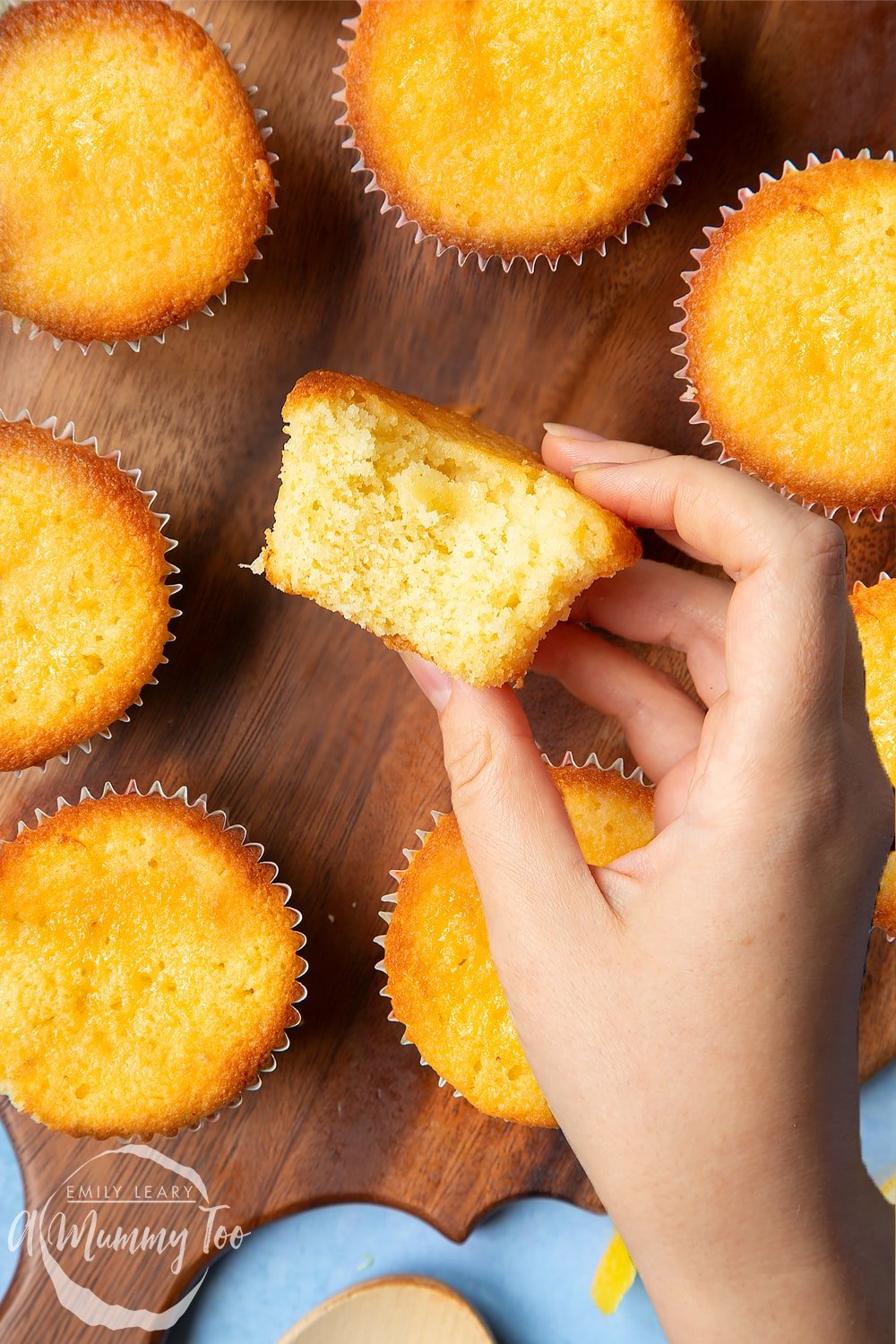
Can I make this lemon drizzle cake as a tray bake?
I haven't tried making this lemon drizzle in a tray, but my guess is that it should work well.
This isn’t a huge cake, so I’d recommend you aim for a tray that’s of a similar size to its 23cm (9 inch) round equivalent. If you go bigger, then you will need to reduce the cooking time as you will be spreading the cake thinner and increasing the surface area.
Keep an eye on your cake as it bakes to make sure it doesn’t go too brown, and press the centre gently to make sure it’s firm. Double-check that your cake is done by pushing a flat skewer into the centre of the cake - it should come out clean.
Can I use this recipe to make a layer cake?
Yes, you can definitely use this recipe to make a layer cake! I would make double the quantity of batter and bake in two 18cm (7inch) tins, then make double the lemon drizzle syrup to drizzle on to them.
Once cooled, they'd be great sandwiched and covered with cool lemon frosting or even cream cheese frosting.

Print this lemon drizzle cake recipe
If you'd like to print this recipe to try later, just hit PRINT on the recipe card below.
World's Best Lemon Drizzle Cake Recipe
Ingredients
- 170 g (⅔+¼ cup) white caster sugar (superfine sugar)
- 170 g (1½ sticks) slightly salted butter
- 2 medium free range eggs
- 170 g (1 cup + 3 tbsp) self-raising white flour (self rising flour) sifted
- 3 unwaxed lemons (A standard UK lemon gives about 2 tbsp of juice. If yours are larger, adjust accordingly)
- 4 tbsp icing sugar (powdered sugar)
Equipment
- Wooden spoon or silicone spatula
- Round 20cm (8") nonstick cake tin or larger up to 23cm (9") for a thinner cake.
Instructions
- Grease and line your nonstick cake tin. If you don't have any greaseproof paper, greasing and then dusting with flour can help prevent sticking.
- Preheat the oven to 180C (160C fan, 350F). Put the sugar and butter in a large bowl and whisk together until fluffy.
- Add both eggs and whisk in.
- Sift in the flour and fold until smooth.
- Add the zest of two lemons and the juice of one to the mixture and gently mix through.
- Spoon the batter into a greased and lightly floured cake tin. I recommend using a nonstick loose-bottomed or springform tin as it makes it super easy to get your cake out of the tin cleanly.
- Bake for 25-30 minutes. (The wider the cake tin, the quicker it will cook). The cake should be golden on the outside and the skewer should come out clean - keep an eye on it as you don't want it to over-bake.
- In a small pan, mix the juice of two of the lemons with the icing sugar.
- Place over a medium low heat and stir until the sugar has dissolved, then bring to a boil for 1-2 minutes until you have a light syrupy texture.
- Poke holes all over the warm sponge with a skewer, almost down to the bottom.
- Take the syrup off the heat (careful, it's hot!) and pour all over the cooling sponge.
- Allow to cool, then cut into generous slices and enjoy with a hot cup of tea or coffee.
Video
Notes
Nutrition
Pin this lemon drizzle cake for later

Looking for more baking inspiration?
Try these incredibly delicious lemon bakes recipes next.
Have you got my book?

'This is a great kids cookery book. Emily is a star' - Simon Rimmer
'The book I'd like to force into any mother's kitchen' - Prue Leith
"A fab book with a plan." - Jane Devonshire, 2016 Masterchef UK winner
'Emily has managed to combine her mummy knowledge and passion for food to make a truly helpful and brilliant cookbook' - Priya Tew, RD, BSc (Hons), Msc
Get Your Kids to Eat Anything is an achievable 'how to' for parents in the battle to overcome picky eating and 'make new the norm'. Emily Leary's unique 5-phase programme looks at the issue of 'fussy eating' in a holistic way that links imagination with food, and which situates parents alongside - not in opposition to - their children.
.


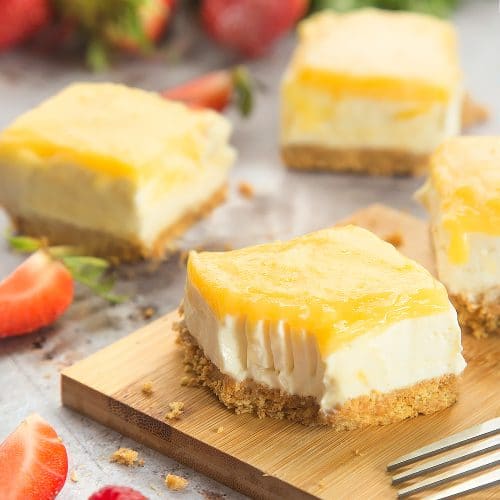
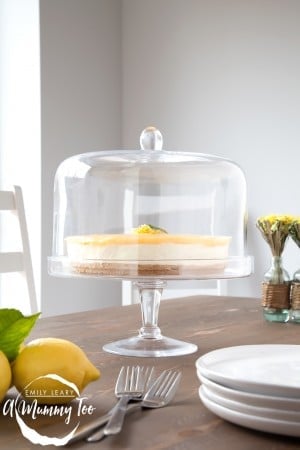

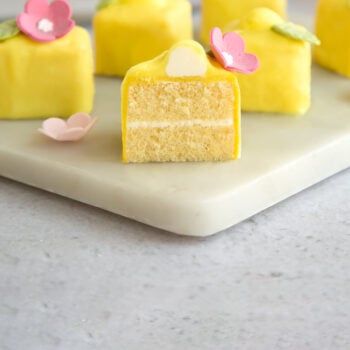
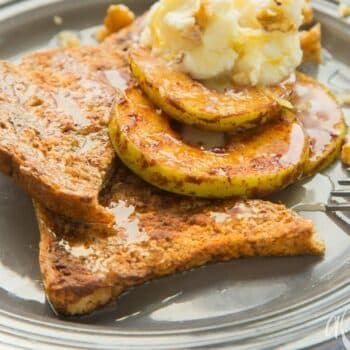
Shylie says
This is hands down the best lemon drizzle cake I’ve ever made or eaten! I’m gluten free so made it with gluten free flour and it still came out light, fluffy and delicious! This is going to be one of my favourite recipes from now on. Thank you so much!
Kate says
Forgot to leave a star rating last time. Making this again right now and another one for my friend's birthday on Sunday. Thanks again xx
Emily Leary says
Brilliant! Thank you and enjoy!
Tara Wyborn says
Best Lemon drizzle cake indeed! I am new to baking and learning.
I have used your recipe few times now. I like the simplicity of the measurement 170 each, 2 eggs and 3 lemons (although I used only 2). So easy to remember and simple steps to make.
I have made it for my teenage nieces, my colleagues and it is a hit every time. Thank you so much for sharing.
Emily Leary says
I'm so pleased!
Lorraine says
The most perfect recipe!! Absolutely delicious!!!
Emily Leary says
Yay I'm so pleased.
Kate says
I'm very hit and miss with cakes. But, this was a massive first time hit!
Excellent recipe! And not too sweet. It'll be a regular and will be a big
help in overcoming my fear of baking.
Thanks so much Emily!
Emily Leary says
Hurray! Glad to hear it and thank you.
Tanisha says
Hi! I made this cake and it tasted delicious but when i took it out the oven it seemed to dip quite a bit in the middle. Do you know why this happened and how i can prevent it from happening next time?
Emily Leary says
Hi. The most likely explanation is that is wasn't cooked through properly and may have needed a few more minutes in the oven.
Tanisha says
Hi! i'm planning to make this lemon drizzle cake soon but i was just wondering if it comes just as well using an 8 inch (20cm) cake tin rather than a 23cm one?
Emily Leary says
Yes, that'll be fine.
Seb says
Excellent recipe, reminds me of the lemon drizzle loaf my dear departed nan used to make. There is no higher praise!
I have made this twice with lemons, and also had success doing it with tangy oranges. (I.e. not sweet ones)
It's worth springing for high-quality, organic lemons to make this -- you really can taste the difference.
Emily Leary says
That's so lovely to hear, thank you. And I agree about the good quality lemons!
Kitcat says
Hi - I wish I had taken a picture because the cake came out perfect and tasted delicious! It was very zingy and lemony and just what I was hoping to bake. My niece who loves lemon cake said it had the best taste ever!
I did add a little vanilla extract to the syrup as i like that vanilla/lemony taste and it worked very well :-)
Just one question - the cake was so moist, soft and very crumbly when cutting slices and the bottom of the cake was a little stuck to the base - did i add too much of the syrup, or make it to sticky to cause that?
Emily Leary says
Hi. i'm glad you enjoyed it! If it stuck to the bottom, that might've made it more likely to break apart. If your tin isn't great nonstick, it's always best to line with baking paper so that it comes out really clean. Did you let the cake cool completely before removing from the tin? Handling it while it's still warm and syrupy might cause it to break up.
Samia Meah says
Hello!
Thank you for your recipe, I made this yesterday! My first attempt at a lemon drizzle. My cake didn't turn a golden colour despite pre-heating my gas oven. When I first looked at the 30min mark it was still wet in the middle. I had to check it a few times so I guess thats why it didn't really rise. The second time I checked, the skewer did come out clean but the cake looked very white. The third time is when I took it out. The cake does feel compacted/dense and kind of lacking flavour or a bit dry in the middle - is this due to being in the over too long or due to me refrigerating it (it's in an air tight container)?
Other than the answers to my above questions, I loved the recipe and the cake! I'd like to improve it for next time.
Samia Meah says
It's me again! I've read the rest of your FAQ and found my answers in there so don't worry - next time I will take it out the over despite it's colour so long as the skewer comes out clean and I will remember not to put it in the fridge, as your notes say, it has lost its soft/tenderness. Still tastes lemony and good though! <3